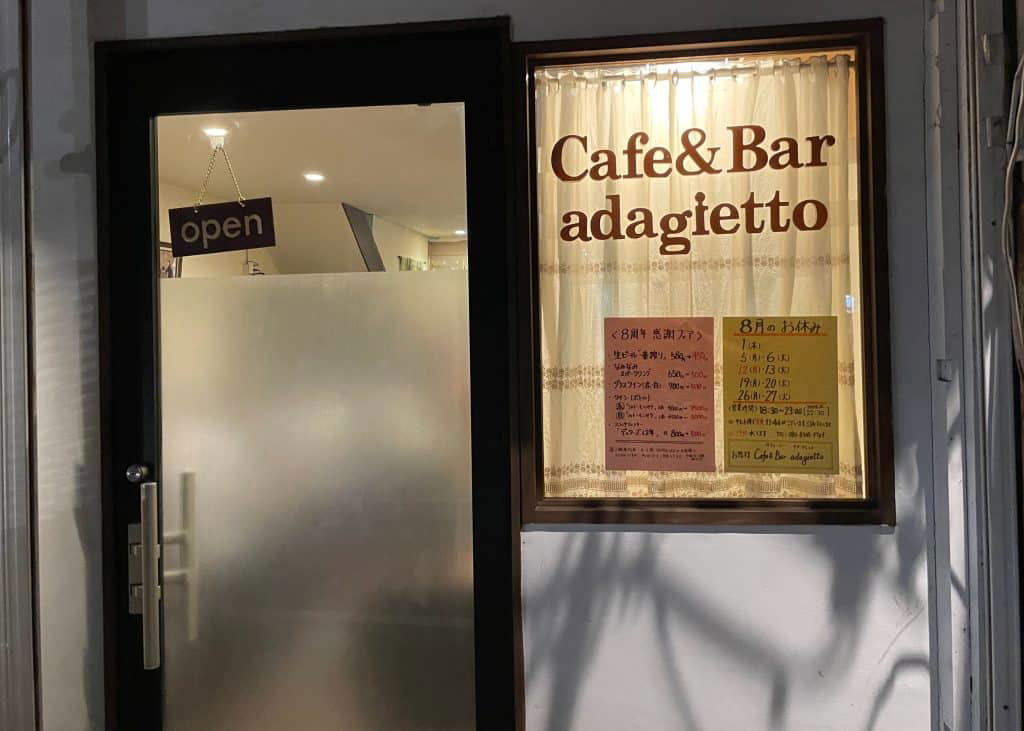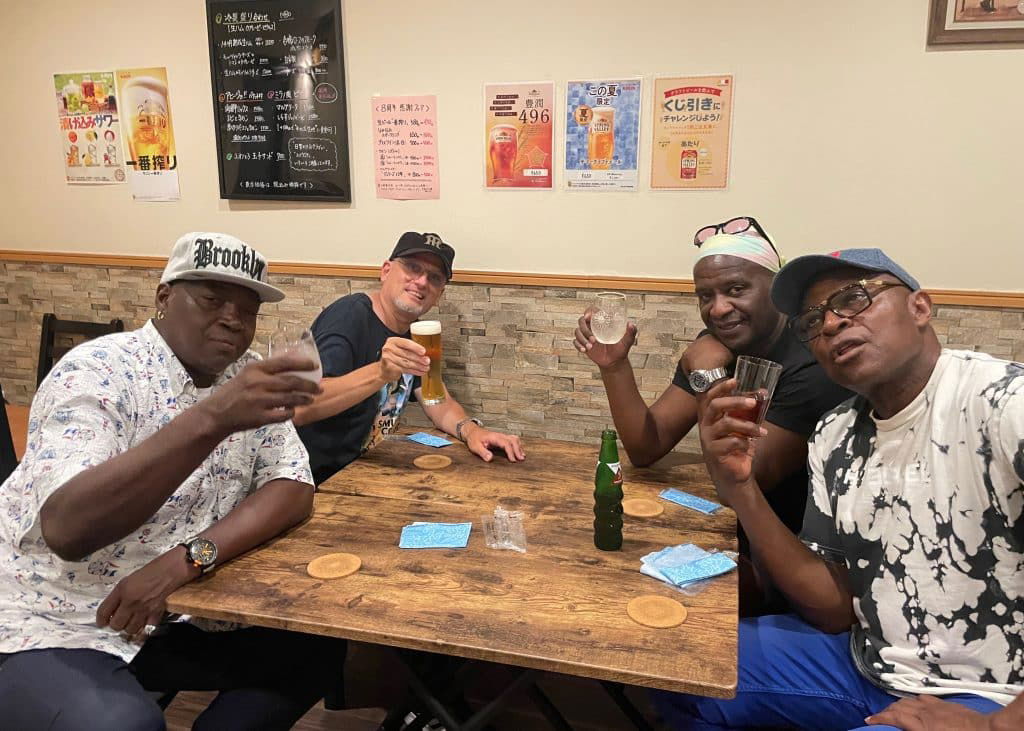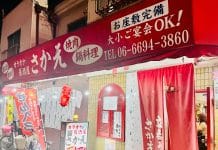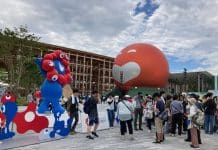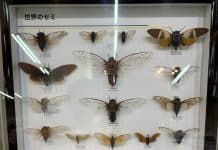Table of Contents
Introduction: Sumiyoshi Taisha to Abikomichi Station
Welcome to another edition of Osaka Daytripping, the ultimate guide to the lesser-known parts of of our favorite city in Japan. This article also serves as the second installment in our four-part series on Sumiyoshi Ward.
In Part One, we covered the history of Sumiyoshi Taisha, which is one of Osaka’s most popular tourist destinations that attracts people from all over the world, and recommended some restaurants and shops in the immediate vicinity. But what do you once you’ve finished exploring the shrine, which is a bit of a trek, especially if you are staying at a hotel closer to the center of town.

Instead of heading to that next big tourist attraction on your list, I recommend that you stick around to explore a few more local spots that are not listed in any guidebook (as far as I know). What’s more, I’m going to show you have to do it for under $10, not including expenditures on food, drinks and any other purchases you choose to make along the way, naturally.
This article covers the stations from Sumiyoshi to Abikomichi on the Hankai Line. In the next installment, I’ll be covering the stations from Sumoyishi to Tennoji-ekimae on the Uemachi Line. The differences between both lines is explained below.
Hankai Tramway
Hankai Tramway, which was established in 1897, is the only tramway connecting Sakai City with Osaka City. It is affectionately known as “Chinden” among locals, and includes four of the oldest trams in Japan that are still operating today. The modern trams are fully air conditioned and rarely get crowded. They are a great way to see off-the-beaten path areas of Osaka that trains and buses often don’t service.

Hankai Tramway, Co. operates two tram routes in Osaka Prefecture. The fist is the Hankai Line which connect Ebisu (Den Den Town) in Osaka City to Hamadera Eki-mae in Sakai City. The second one is the Uemachi Line which connections Tennoji Eki-mae with Sumiyoshi Stations. You can switch between the lines very easily, often without getting off the tram. A detail map in English can be found here.
The Take Take 1 Day Pass: Unlimited Rides All Day
The standard adult fare for a one-way ticket is ¥230 (¥130 for children), no matter if you take the tram one stop or all the way to the end of the line (IC card or cash accepted. Make sure you have coins ready). Full disclosure from someone who now knows better: My wife and I once spent an entire afternoon riding the tram and getting off at any stop that looking interesting. It was loads of fun, but we ended up spending over 2,000 yen each on our little excursion because having to pay the fare each time adds up.
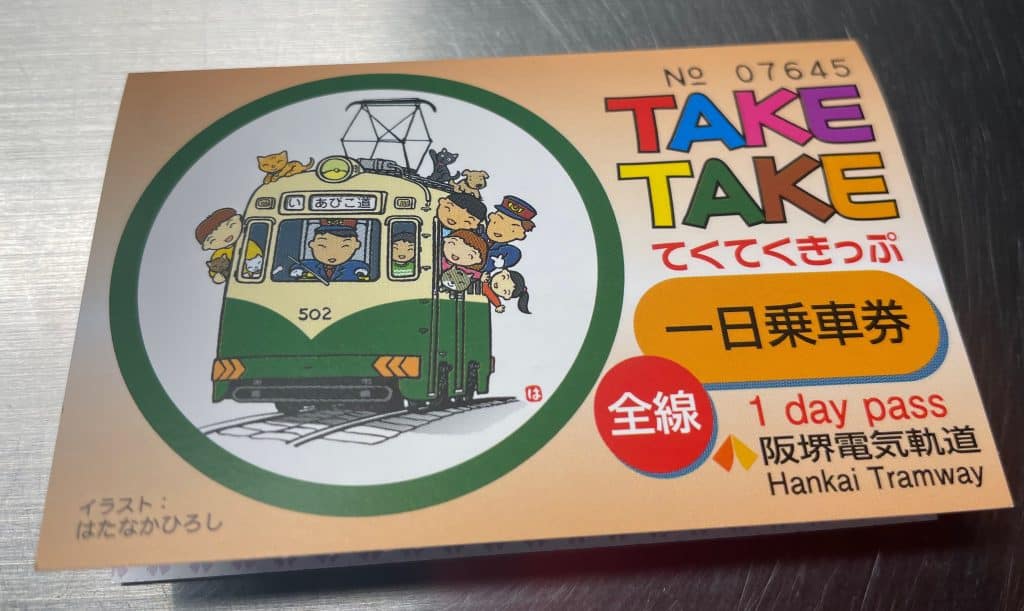
We realized that we could have saved money by purchasing a Take Take Pass for only ¥700 yen (¥350 yen for children) that would have allowed us to ride the tram all day. It really is a game changer. I purchased my pass from a ticket booth at Tennoji Eki-mae station, but youy can buy them from the conductor. I know that Japan is known for being a technology-advanced country, but you still have to scratch off the date with a coin by yourself, just like those “scratch to win” cards they sell at gas stations in the US.
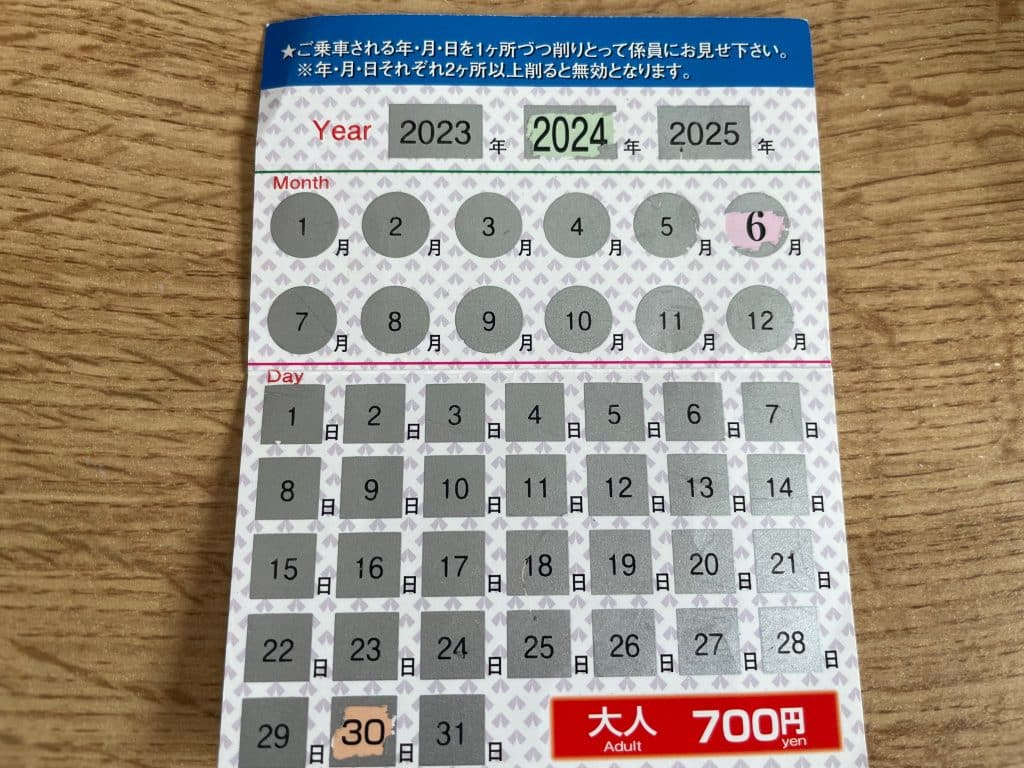
You can purchase a digital version of the Take Take Pass by downloading an app here, although there doesn’t seem to be any English instructions. If anyone has done this, please let us know in the comments. I prefer the analog version.
Sumiyoshi Station 住吉留場
All lines lead to Sumiyoshi Station, one of two major hubs of the Hankai Tramway. If you are traveling on the Uemachi Line from Tennoji-mae Station you can take the train all the way to Hamadera-Ekimae Station in Sakai, which has one of the oldest parks in Osaka, Hamadera Koen, established in 1873. All trams from Ebisucho only goes as far as Abikomichi. You can switch at Sumiyoshi Station or Abikomichi to go on to Sakai.
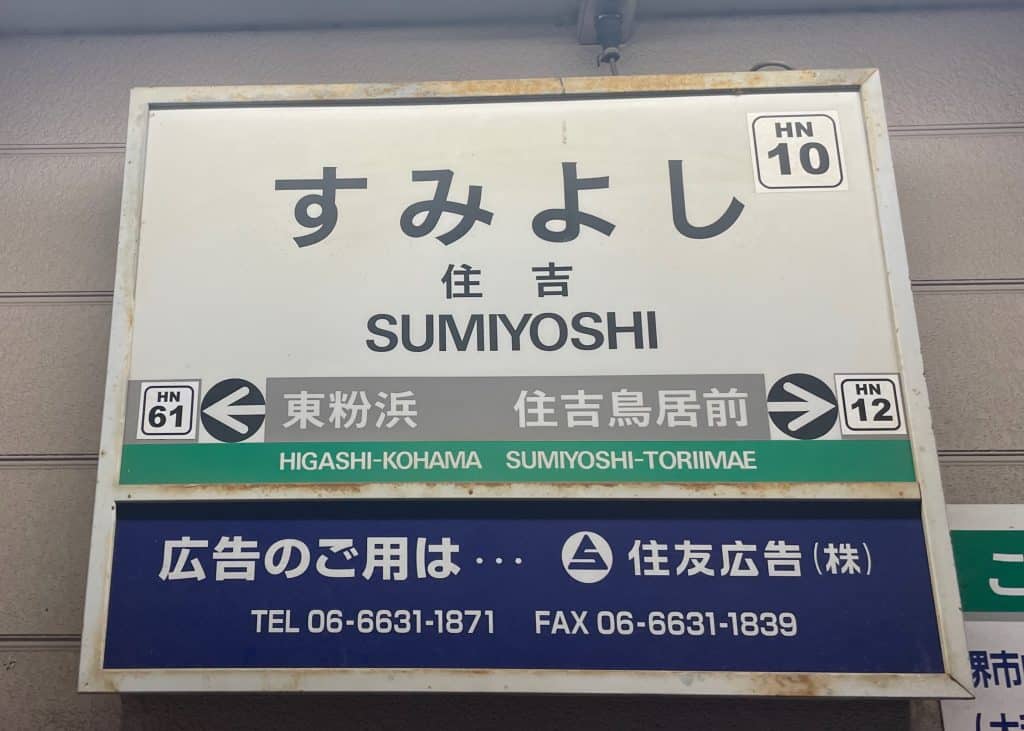
All stations on the Hankai Tramline are officially known as “tomeba” (留場), which means “stop,” for a bus or a streetcar. However, if you search for Sumiyoshi Eki (住吉駅) on Google Maps it will still show up.
Enmajizoson 閻魔地蔵
Address: 3 Chome-5-11 Higashikohama, Sumiyoshi Ward, Osaka, 558-0051.
We have come to Enmajizoson to see the 492-year-old statue of the deity King Enma (閻魔王, Enma-ō), the god of death and the underworld. The Hall is located on exact spot where six different roads meet in what was once the former village of Kohama in ancient times. This is called “Rokudo-no-Tsuji” in Japanese, which literally means “Crossroad of the Six Paths,” but it has a deeper spiritual meaning in Buddhism.
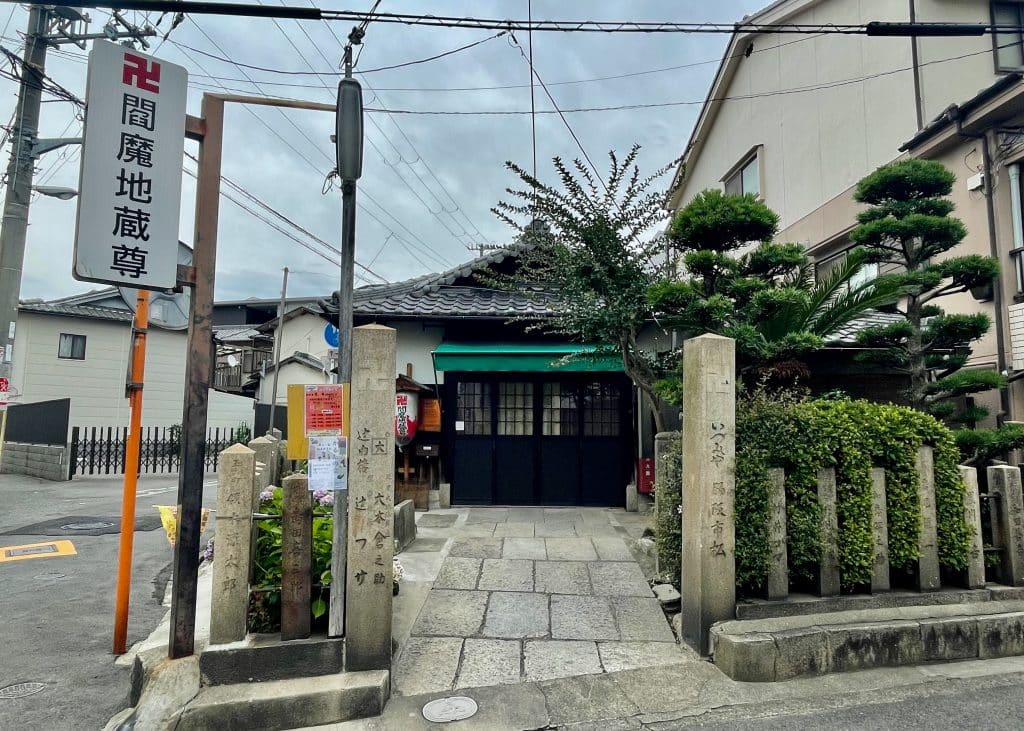
Enmajizoson is a scant five minute walk from Sumiyoshi Station. Ordinarily, I would have walked past it without a second thought. However, after reading Gary Luscombe’s excellent article on Osaka’s Top 3 Off the Beaten Track Temples, I have become more conscious of historical entities in local neighborhoods.
The first time I visited this area I took a photo of the hall and started doing research when I arrived home. One I started reading about King Enma and the six forks in the road, I was hooked, but 99% of the information had to be translated, which took more time than I expected.
Six Forks in The Road
In Buddhism, “Rokudō no Tsuji” (六道の辻) refers to the “Six Realms of Existence” or the “Six Paths,” which are the six states of existence into which beings are reborn according to their karma. This concept is part of the broader understanding of samsara, the cycle of birth, death, and rebirth. Rokudo Chinnou-ji Temple in Kyoto is perhaps the most famous Six Roads Crossing in Japan, believed to mark the boundaries between this world and the next.
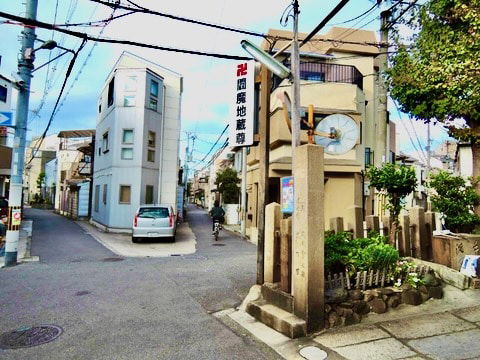
In the past, there were many Rokudō no Tsuji across Japan, but modern redevelopment has erased most traces of these complex intersections. However, the one where Enma Hall is located now has seven roads that intersect. As one Japanese blogger pointed out: Can you imagine drunkenly wandering around in the black of night and having to choose between seven options to get back to your Air BnB? It’s no wonder the younger generation is baffled by how anyone ever found an address in Japan without GPS.
Meet The God of Death and The Underworld
King Enma, also known as Yama in Sanskrit, is the deity who presides over the afterlife and judges the dead. Often depicted as a fearsome figure seated on a throne and surrounded by attendants, King Enma evaluates the deeds of individuals during their lives and decides their fate in the afterlife. The souls are assigned to one of the six paths: the world of celestial beings (deva), the world of warlike demigods (asura), the world of human beings (manushya), the world of animals (tiryagyoni), the world of hungry ghosts (preta), or the world of Hell (naraka).
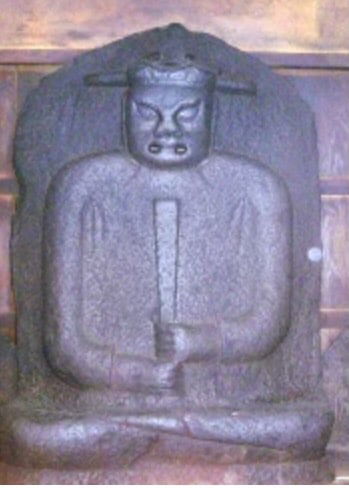

Enma Jizo, as the 1.2 meter statue in known, was created in Tenbun 7 (1538). The deity is depicted in half-relief form, holding a Shaku and seated in a cross-legged position. The deity, whose face is said to be terrifying, but kindhearted, was originally enshrined at Namba no Hamabe, a beach in Namba along the coast of Osaka that no longer exists due to centuries of land reclamation and urban development.
The hall fell into disrepair during the anti-Buddhist movement of the Meiji period, but is now protected by the Enma Jizo Caretaker Association, which was formerly made up of 13 houses, but now consists of four houses. Enma Jizo was named Designated Cultural Property (指定文化財) by Osaka City in 2013.
Monthly Goma Fire Ceremony at Enmajizoson
The Goma Fire Ceremony, also known as homa (護摩) is held at Enma Jizoson the 24th of each month. The ceremony involves the burning of wooden sticks or tablets known as gomadaki that are inscribed with prayers and wishes. The fire is considered sacred and believed to have the power to purify negative energies, fulfill prayers and bring about various benefits. Offerings such as rice, flowers and incense are made to the deities.
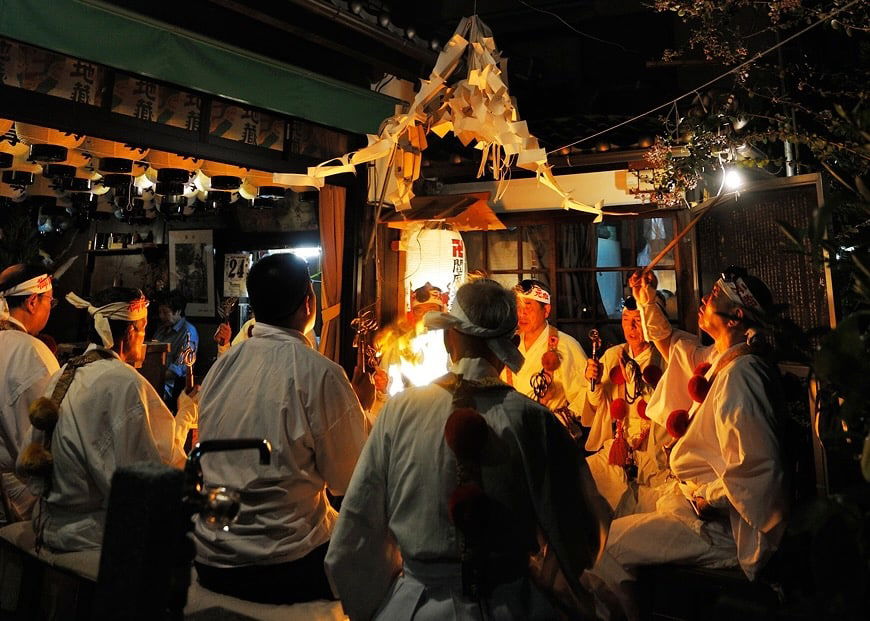
Jizo Bon at Enmajizoson : August 23rd and 24th
In Japanese Buddhism, Jizo Bosatsu (地蔵菩薩, or Jizo Bodhisattva) is sometimes associated with King Enma (閻魔王, Enma-ō), the judge of the dead. This connection stems from their shared roles in guiding and protecting souls, particularly those suffering in the afterlife.
Jizo Bon (地蔵盆) is a traditional Buddhist festival in Japan dedicated to Jizo Bosatsu, usually held in August. This year, the festival at Enma Hall will take place on August 23rd and 24th. Normally, only the face of the King Enma statue is visible from behind a curtain, but during Jizo Bon, the entire figure is revealed.
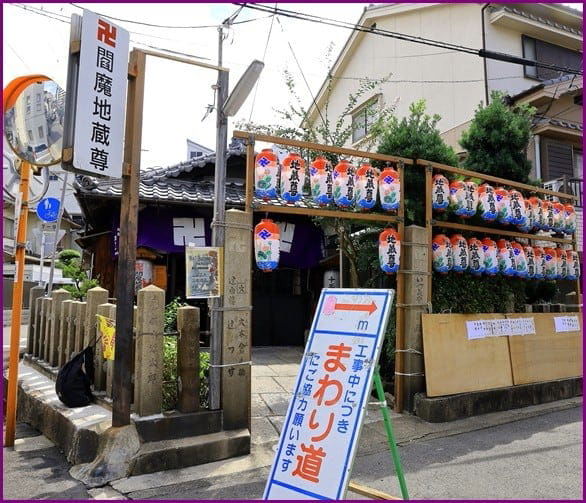
Sumiyoshi Torii-mae Station: 住吉鳥居前留場
Sumiyoshi Torii-mae dates back to December of 1911. Trams heading for Ebisucho stop directly in front of the large stone torii gate at Sumiyoshi Shrine, while trams going to Hamaderaeki-mae stop on the opposite side of the street near Sumiyoshitaisha Station the Nankai Line. There are no platform roofs so be sure to bring an umbrella if it rains.
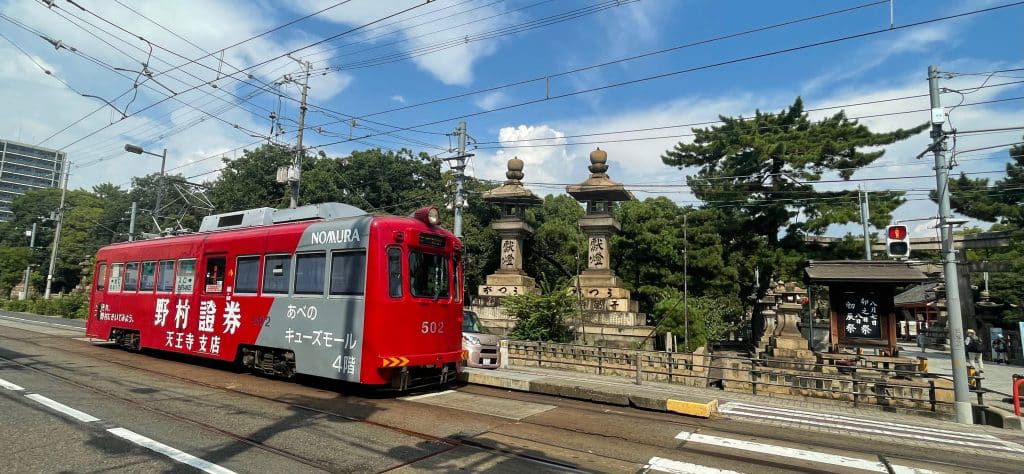
Tramspotting
Because of it’s picturesque location, Sumiyoshi Torii-mae station is considered a prime spot to photograph trams by Tetsudo Fans (鉄道ファン), railroad enthusiasts. The Hankai Tramway operates a fleet of 36 trams. The oldest model dates back to 1928, while the newest trams, from 2016 and 2020, feature three short connected carriages that bend at the joints to navigate urban environments. These modern trams also have ultra-low floors for easy access to luggage, strollers, and passengers with disabilities
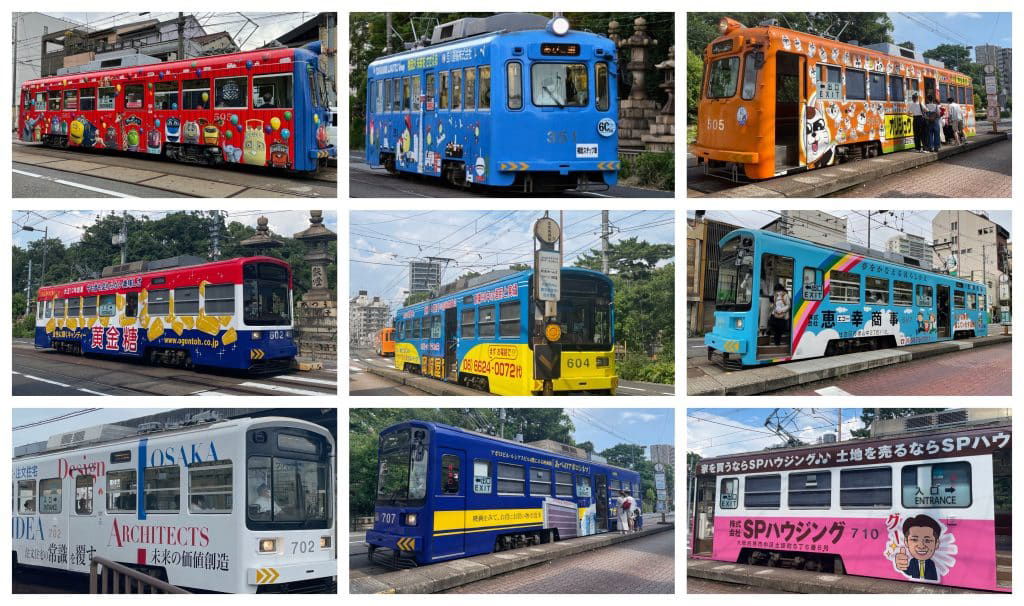
Long Tram Running: Mo161 Series (1928)
The most beloved trams on the Hankai Tramway are the four vintage street cars in the Mo161 series (Mo161, Mo162, Mo164, Mo165), manufactured in over 95 years ago, making them the oldest trams in operation in Japan. (モ161, the character “モ” (pronounced “mo”) stands for “motor car” or “electric car.”).

The Mo161 series is so popular that they’ve inspired a line of plastic replica models and appeared on stamps issued by Japan Post. There is even a mascot who entertains children at local events. If I was a Hollywood agent I wouldn’t hesitate to pitch a film about the Mo161 Series to Pixar; there is no doubt in my mind that it would be the biggest thing since Thomas The Tank Engine.
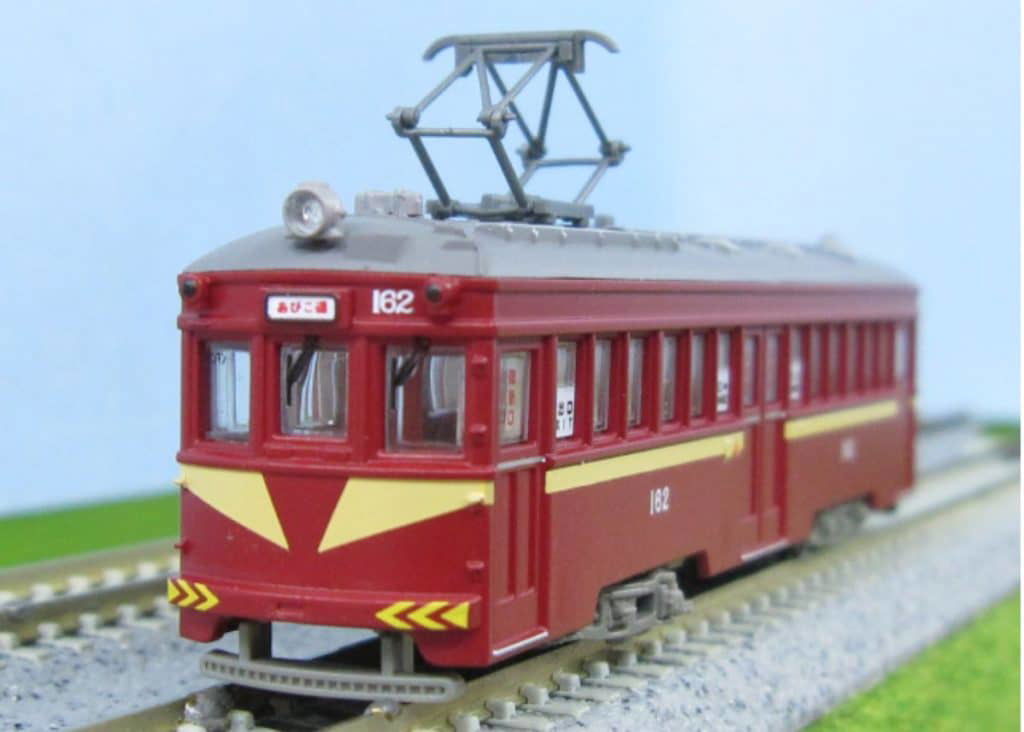
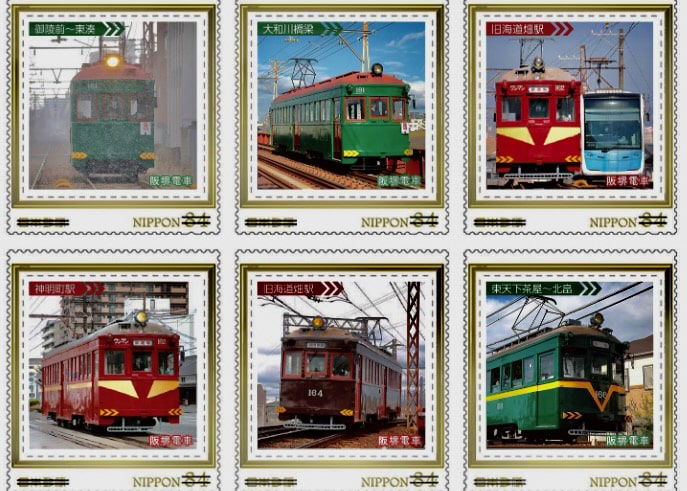
The rock star of the fab four is the first number in the series is without a doubt the the Mo161, which was manufactured in 1928. In 2011, the street car was restored to it’s Showa 40s (1965-1974) design after over 14 million yen was raised through crowdfunding and private donations. Fans of this legendary street car can even purchase a loaf of bread called Chinden Pan manufactured by a bakery in Sakai.
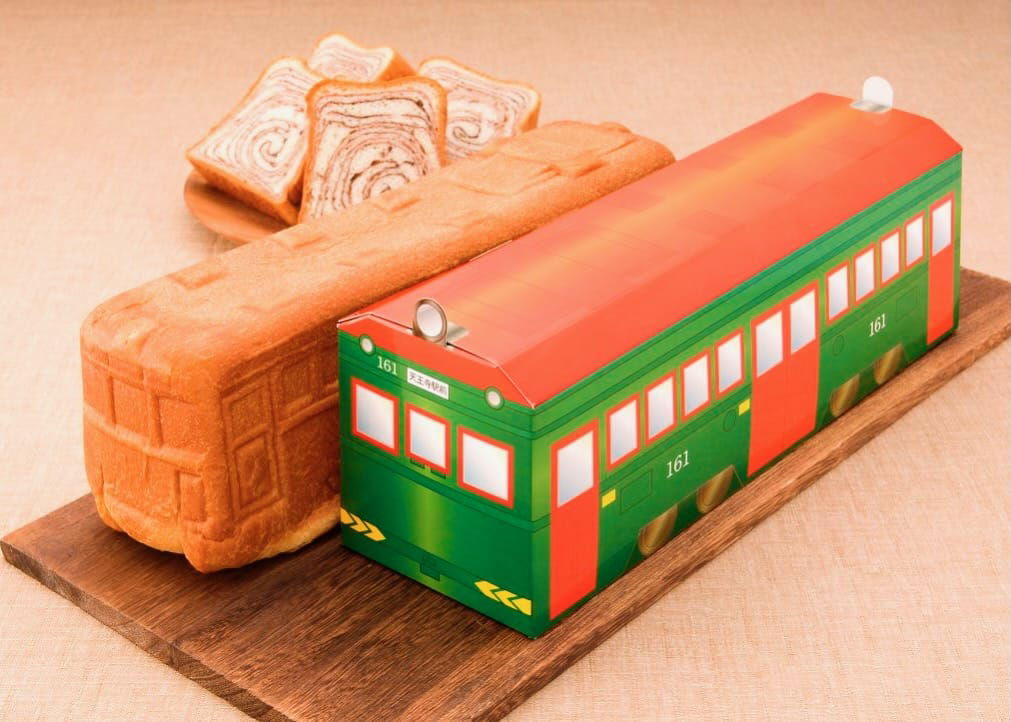
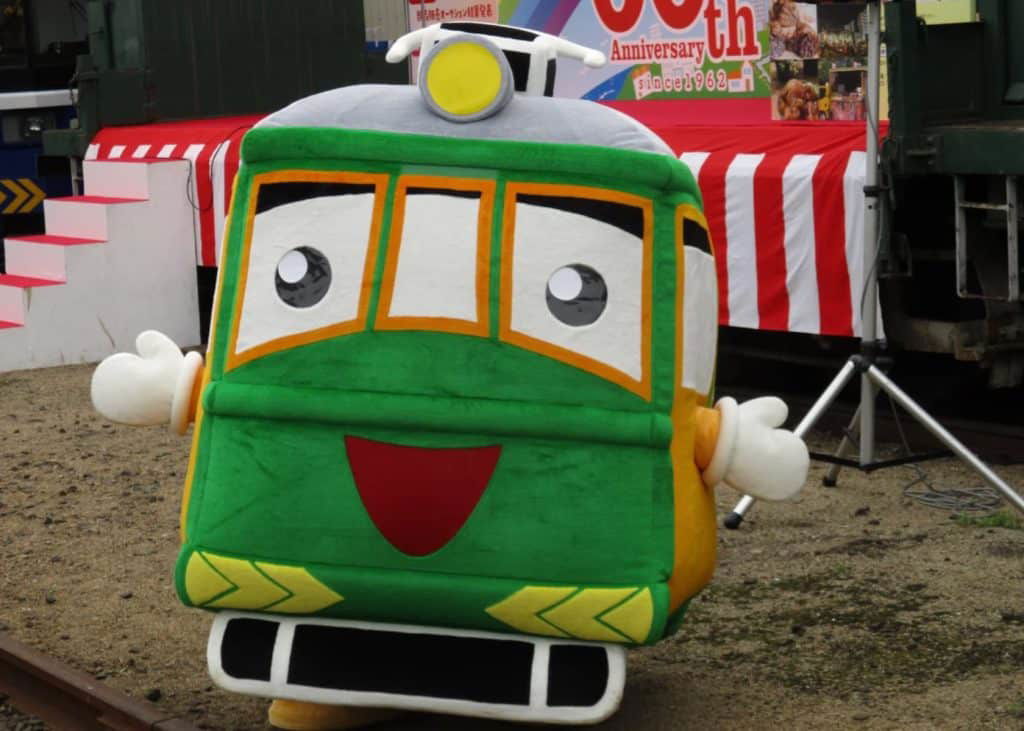
Unlike the other cars on the Hankai Tramway, the Mo161 models are not air-conditioned, so they only run from November to early June. In 2024, the only car currently in operation is Mo162, which was painted red in 2020 in collaboration with the Chikuho Railway in Fukuoka. Currently, the Mo161 is only used for chartered tours and special events. Mo164 and Mo166 were removed from regular service in 2024, and it is uncertain if they will return.
Tram Kept A-Rolling
Hankai Tramway holds events periodically in which all four cars in the Mo161 series are brought out of retirement, and I was fortunate to attend one such an event in May. The streets from Sumiyoshi Taisha Torii-mae to Sumiyoshi, one station over, were lined with excited train enthusiasts, many holding cameras with telephoto lens. It was nice to see small children perched up on their parents shoulders hoping to get a glimpse of these almost 100 year old trams as they pulled into the station.
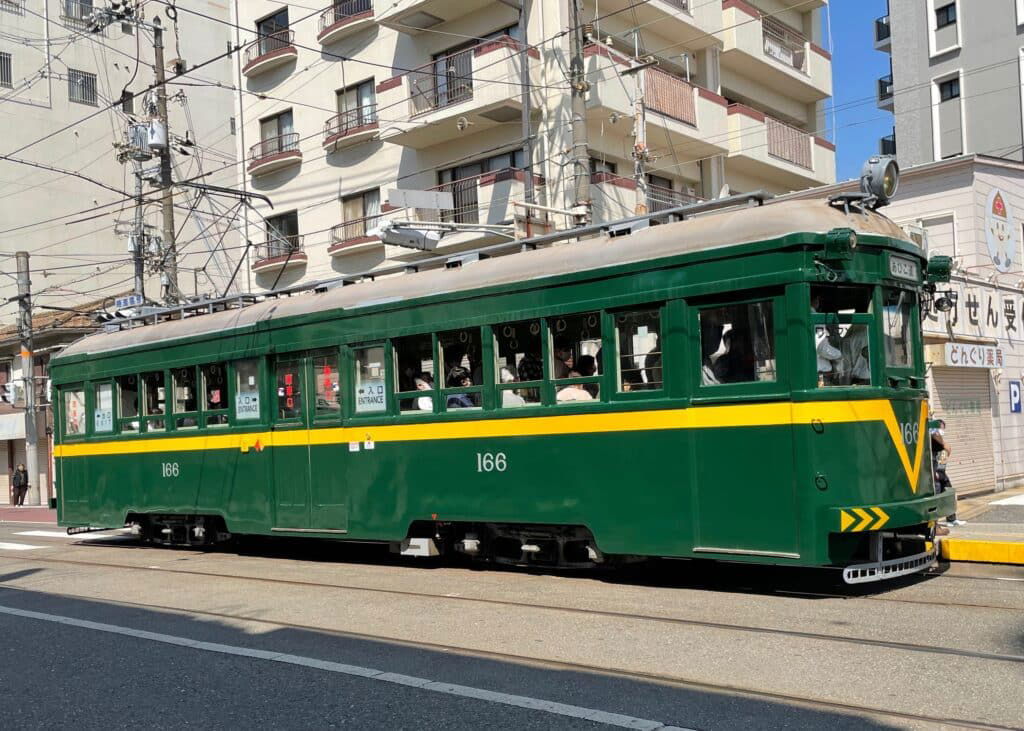
The Passenger
I never had much of an interest in waiting around to photograph motor vehicles before this event, especially since “trainspotter” is a pejorative term in some circles, but after reading up on the historical significance of each model I found myself eagerly anticipating the arrival of not only the classic series, but the newer models as well, many which are painted with colorful advertising for local businesses. There was a cheer from the crowd when the emerald green Mo166 arrived, and I even got to ride the brown and red Mo164 with excited passengers.
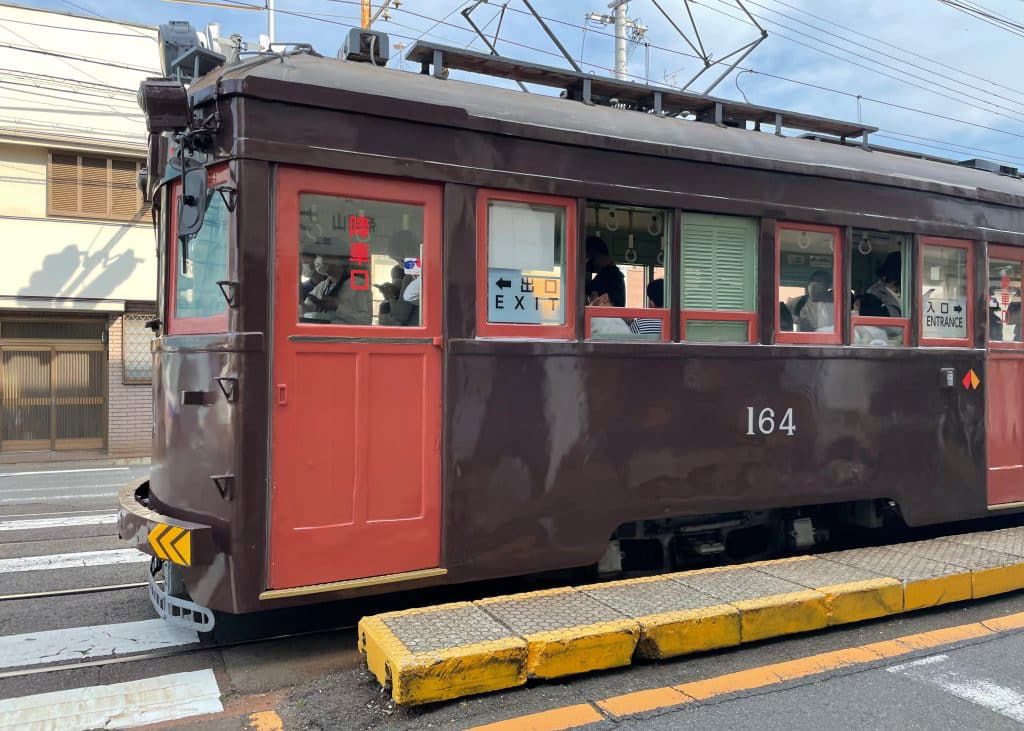
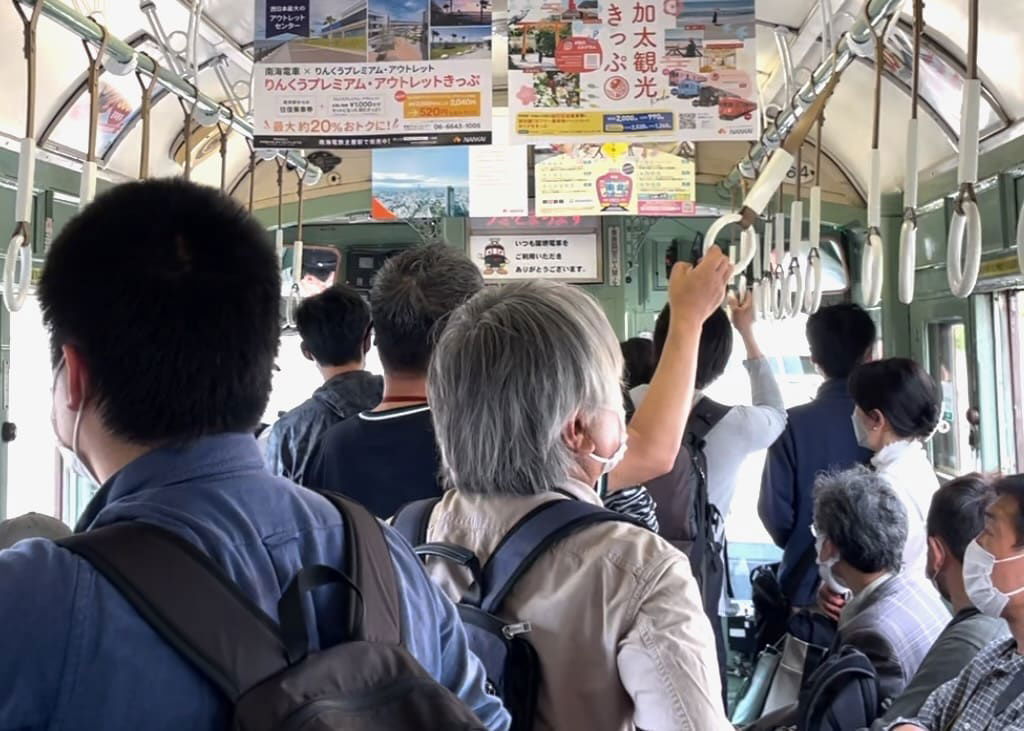
Watching the well-traveled old motor cars and sleek newer models pull up to the station reminded me of one of my favorite picture books from childhood: The Little Engine That Could. For more information about specific cars please check out this excellent website in English run by a train enthusiast.
Please check the Hankai Tramway Twitter for future appearances of the Mo161 series and other events.
Hosoigawa Station 細井川留場
Hosoigawa Station, which opened in 1911, is named after the Hosoigawa River, which flows nearby. The official name of is the “Hosoe (細江) River” and in ancient times it was the site of Sumiyoshi Port, which was discussed in detail by Sayaka Takami in part one of this series. The fairy tale character Issun-boshi is said to have set out from this Hosoe River on his journey to the capital.
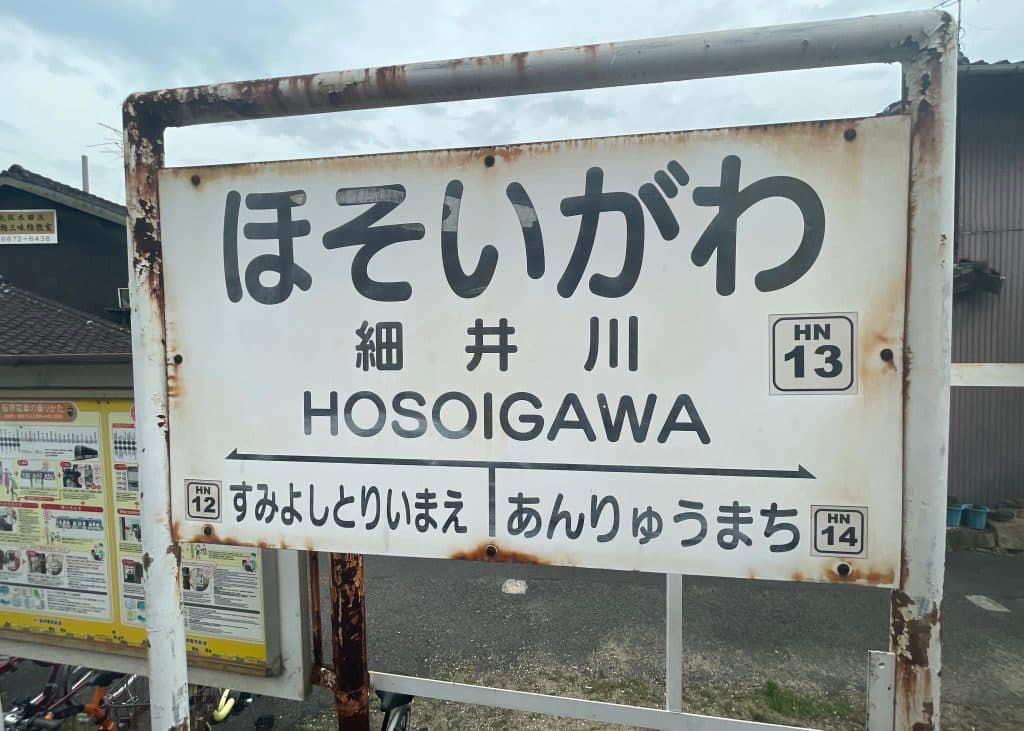
One of the nice things about walking along the tracks of the Hankai Line is that you come across a lot of old picturesque buildings and scenes of nature. On our journey we spot a crane walking in the Hosoigawa River. Could it be the reincarnation of Isshun-Boshi?
Sumiyoshi Angu: Site of the Temporary Palace at Seiinden 住吉行宮(正印殿跡)
Address: 2-7-20 Sumie, Sumiyosho-ku, Osaka City.
Sumiyoshi Angu (Seiinden-ato) translates as “The Site of the Temporary Palace in Sumiyoshi at Seiinden Hall. The term “Angu” refers to temporary palaces established for the Emperor and his entourage during visits to major shrines and temples across Japan. Seiinden (正印) was the name of the hall situated inside the residence of Kunikazu Tsumori, the 52nd head priest of Sumiyoshi Taisha. It was converted into a temporary palace in 1352 for Emperor Go-Murakami, Japan’s 97th emperor, who reigned from 1339 to 1368.
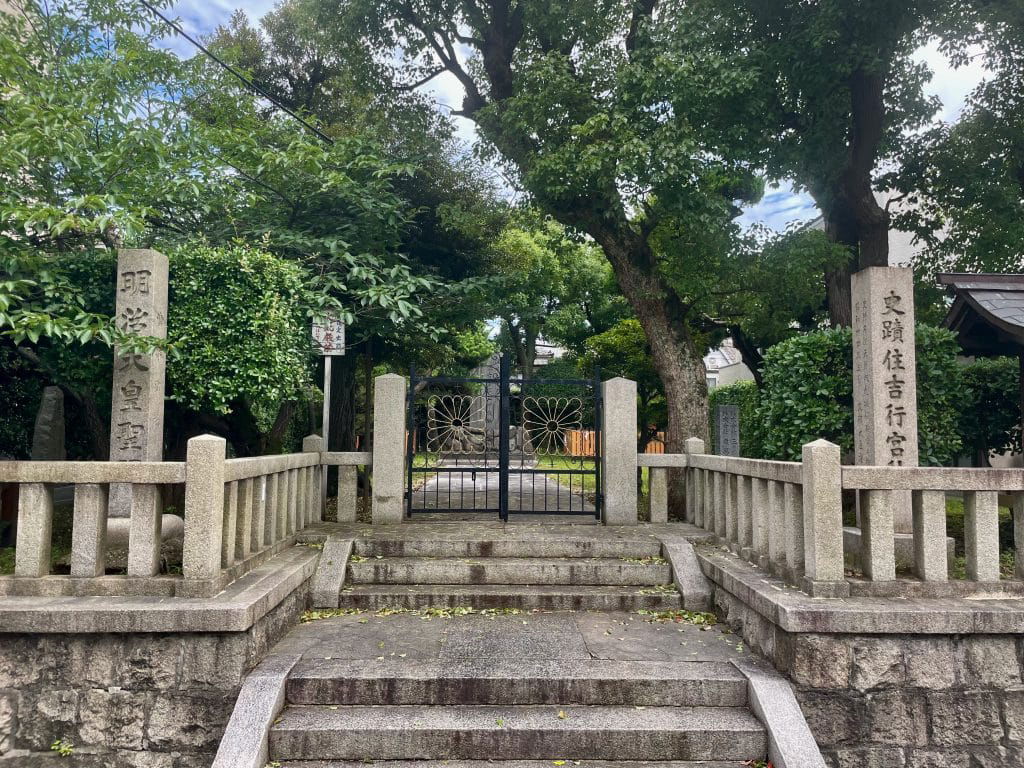
Emperor Go-Murakami, who ruled the Southern Court based in Yoshino, was a key figure during the Nanboku-chō period, a time marked by conflict between the Northern and Southern Imperial Courts. The Emperor frequently visited Sumiyoshi Taisha and eventually decided to relocate there from Yoshino. In 1352, he designated Seiinden as his official temporary palace. Soon after, Sumiyoshi Angu became the focal point of the Southern Court’s efforts to regain power.
Emperor Go-Murakami passed away at Sumiyoshi Angu in 1368. After his death, his successor, Emperor Chōkei, returned to Yoshino upon ascending the throne.
Visiting Sumiyoshi Angu
The site of Sumiyoshi Angu was designated a National Historic Site in 1939, yet it remains far from a typical tourist attraction. Most visitors to Sumiyoshi Taisha likely have no idea that another important cultural property lies nearby. Although understanding the complex history of Sumiyoshi Angu wasn’t easy, I’m excited to visit the site for the first time with my wife, an Osaka native who has never been there herself.
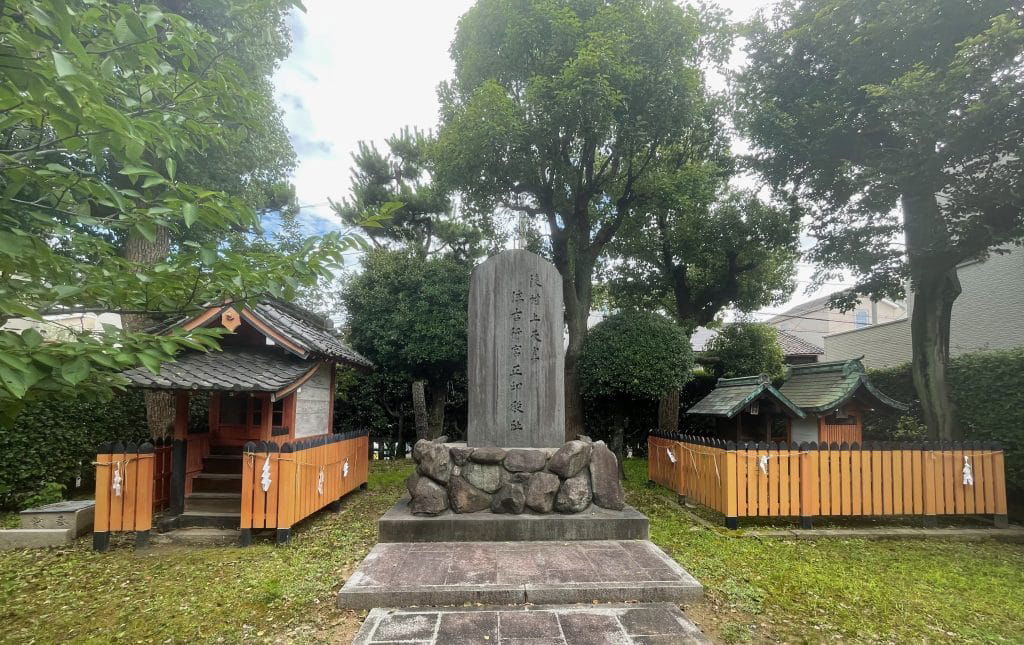
It takes us about seven minutes on foot to reach our destination from Hosoigawa Station. It is a pleasant walk with a few sharp turns onto narrow streets, but we would have never found it without using GPS. Sumiyoshi Angu is enclosed by a stone fence and there are two pillars on either side of the steps, which lead up to a black metal gate that is adorned with two gold Imperial Chrysanthemum Seals.
At first glance, the grounds of Sumiyoshi Angu might not seem open to the public, but anyone can enter when the gates aren’t locked. Once inside, it’s hard not to feel the weight of history. Just moments ago, we were strolling through a residential neighborhood with children playing in the streets. Now, we find ourselves in a place that profoundly influenced the future of Japan nearly seven centuries ago.
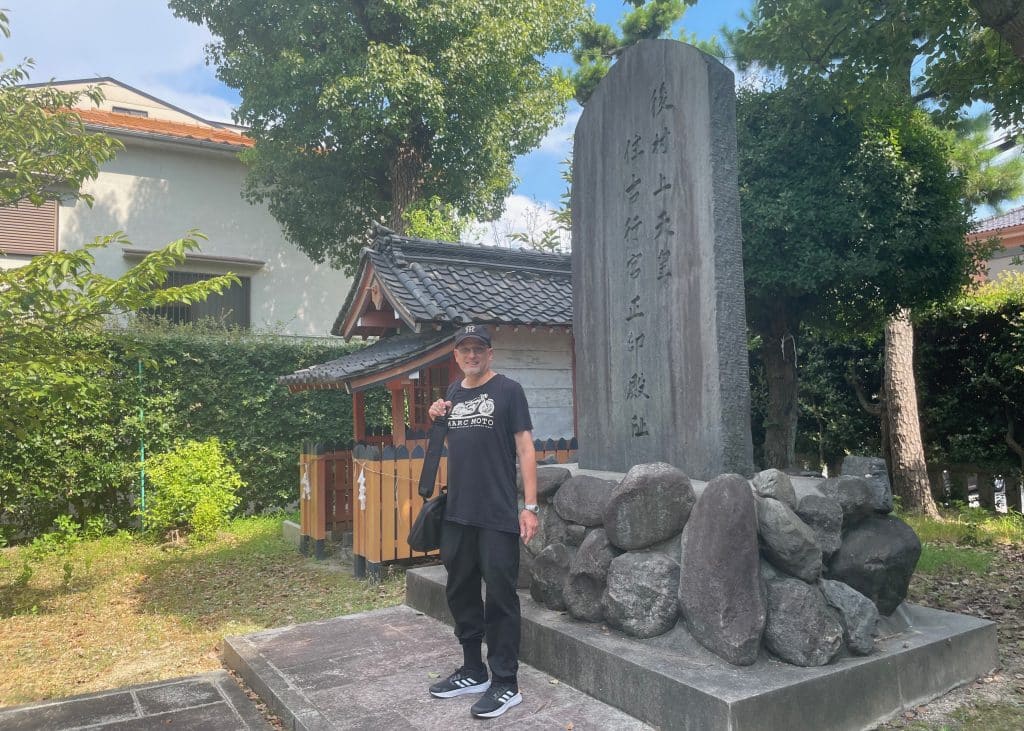
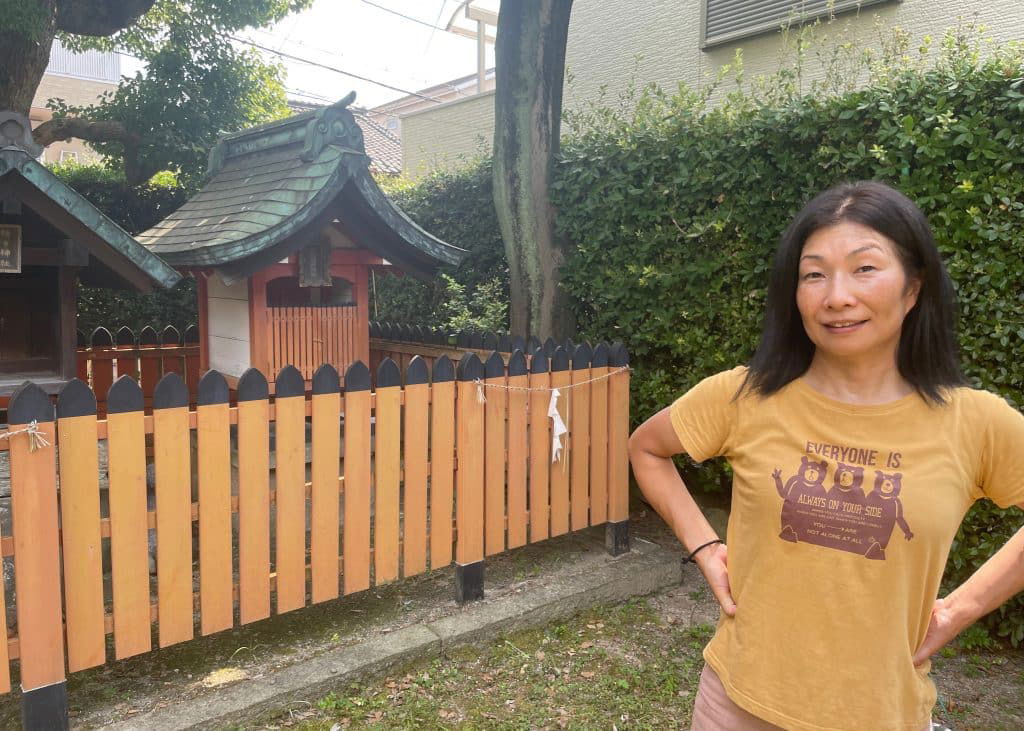
Stone Monuments
In middle of the immaculate grounds there is an impressive stone monument that is inscribed with (roughly) “Site of the Sumiyoshi Imperial Villa of Emperor Go-Murakami.” The monument is located in front of three small buildings called hokora (祠 or ほこら). Hokora are miniature shrines that are often dedicated to kami (Shinto deities) or protective spirits. They are typically found in various locations, such as by the roadside, in gardens, or near larger shrines, and serve as places of worship or protection.
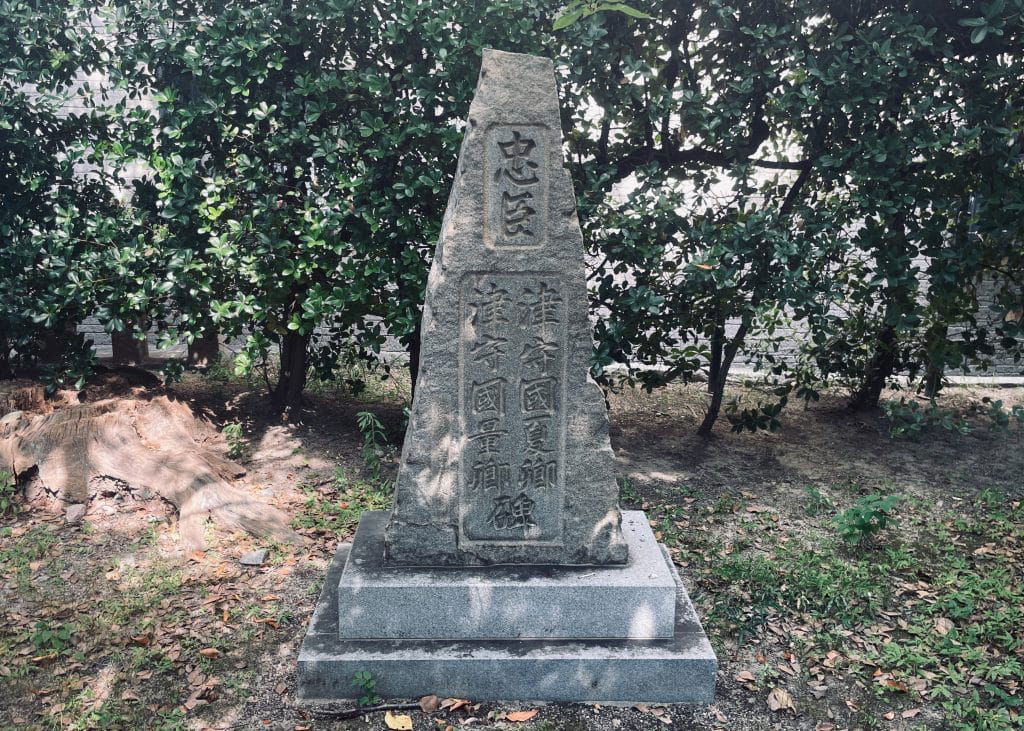
There are a lot of beautiful trees on the premises and its nice to be outside in the fresh air in such a peaceful environment. We come across a smaller stone monument honoring two loyal subjects of the Emperor: Kunikazu Tsumori, the aforementioned head priest of Sumiyoshi Taisha, and his father, Kuninatsu Tsumori, the 51st head priest who served Emperor Go-Daigo.
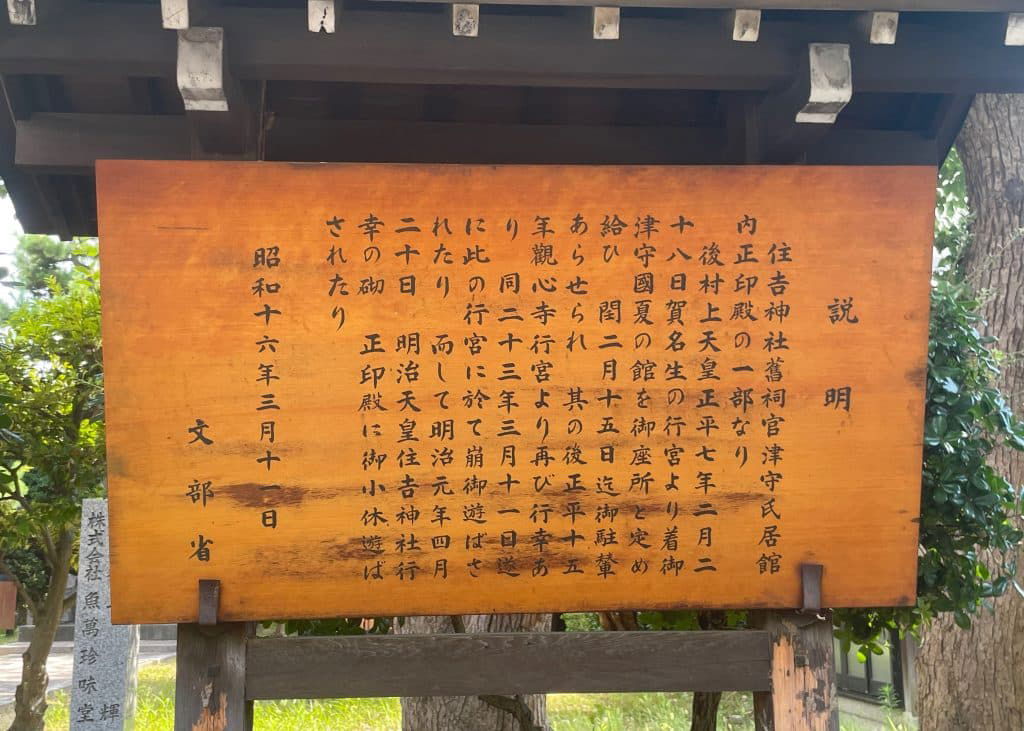
After spending hours researching Sumiyoshi Angu, I was confident that I knew everything about this historic site. Just as we were about to leave, my wife paused to read the beautifully scripted text on a wooden sign out front. To my surprise, she pointed out a detail I had missed: the Meiji Emperor stayed at Sumiyoshi Angu on April 20, 1868, after lodging at another temporary palace within the grounds of Sumiyoshi Taisha.
Hōrai Hanten Chinese Restaurant 蓬莱飯店
Address: 3 Chome-14-13 Sumie, Sumiyoshi Ward, Osaka, 558-0043. Tel:06-6678-6430. Open:11 AM–2 PM, 5–8 PM. Closed: Tues.
It is time to eat lunch. My wife and I decide to go to an old neighborhood Chinese restaurant we passed on the way to Sumiyoshi Angu called Horai Hanten. Hōrai (蓬莱) is Japanese for Mount Penglai, a legendary place in Chinese Mythology. Now you know where popular restaurant chain 551 Horai gets its name. I am not really a fan of their pork buns, but it happens to be our most popular article of all time so I will refrain from commenting further.

In recent years these type of nostalgic “machi chuka“(町中華) restaurant have gotten very popular with young people, and an upcoming article on Osaka.com will introduce the best old local Chinese restaurants in the entire prefecture. Consider Horai Hanten a preview of what to expect. It should be noted that gachi chuka is a newer term used to describe authentic Chinese food from abroad in Japan.
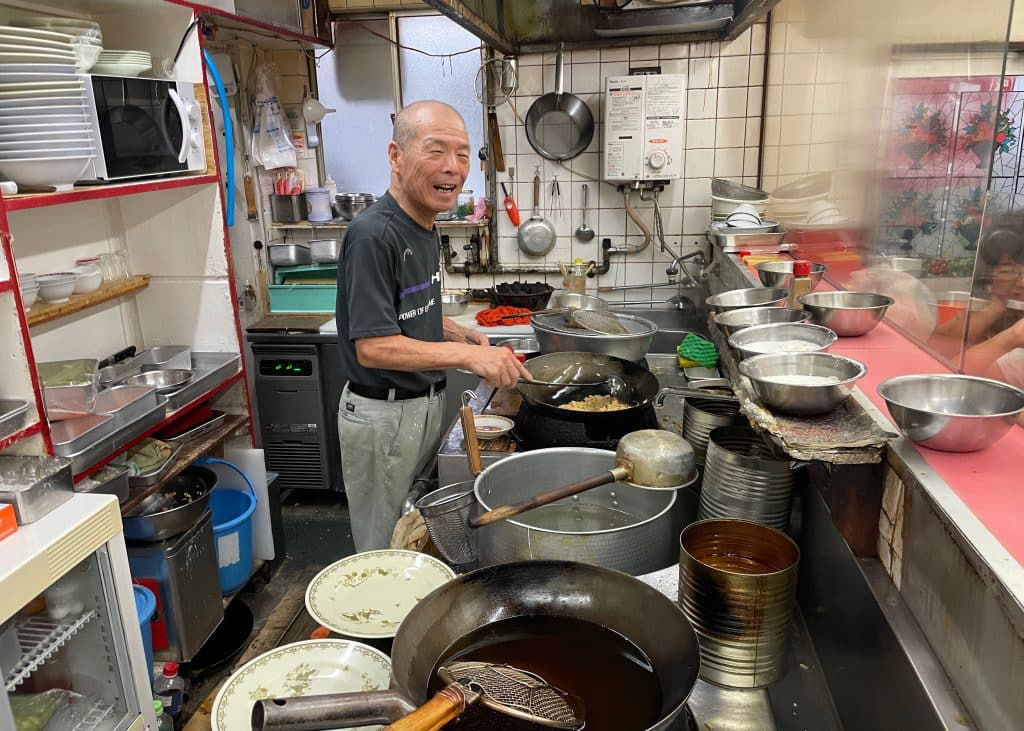
Gyoza and Spring Rolls
We order gyoza and harumaki (spring rolls) to start off. The gyoza is superb and the spring rolls are a bit unique: the filling is wrapped inside a layer of tamagoyaki (rolled egg), making them less crunchy than regular spring rolls, but equally delicious. Besides, I come to local places like this to try something new and I wasn’t disappointed.
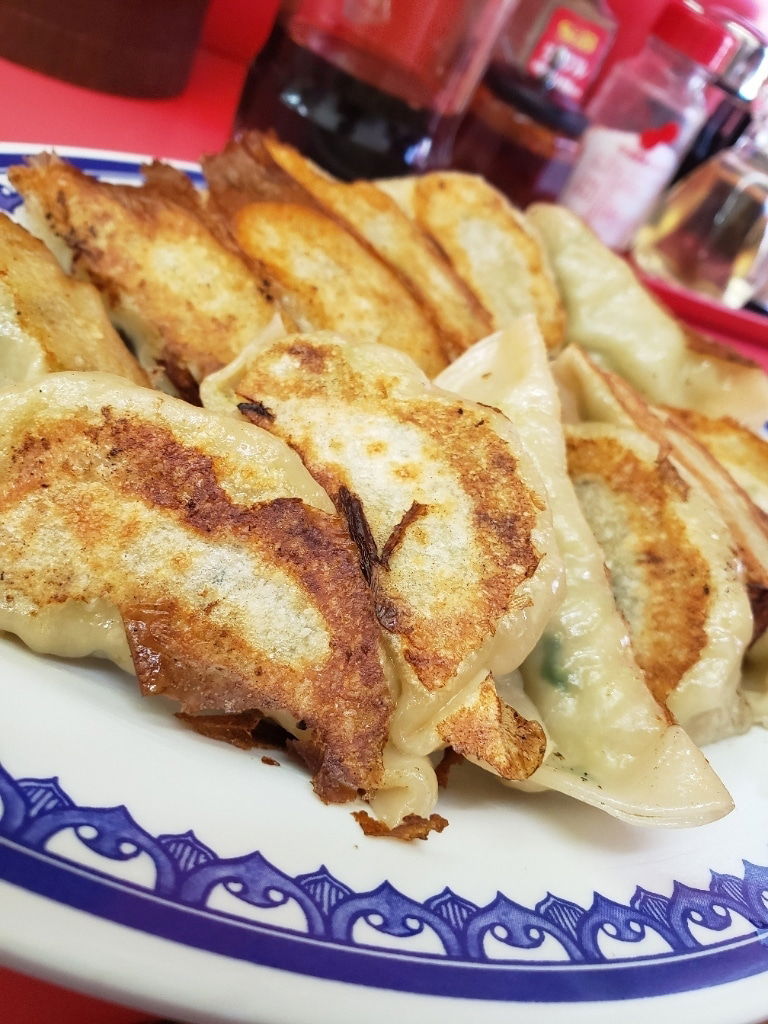
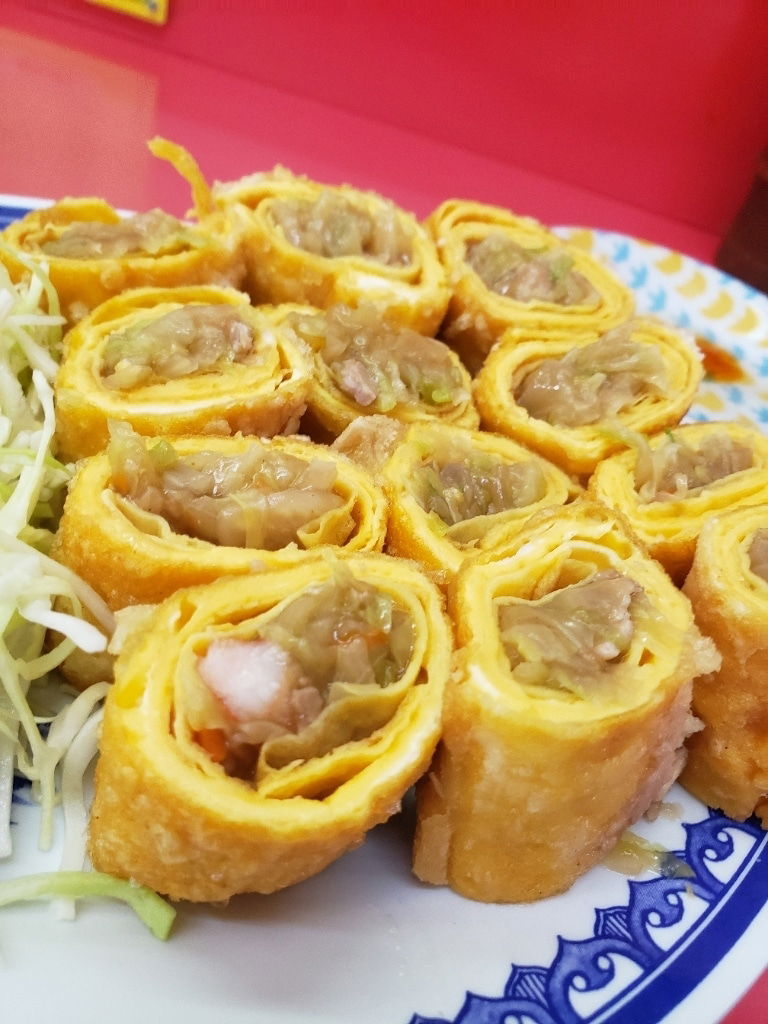
Bifun and Jingisukan
For the main course my wife ordered, Bifun, fried rice vermicelli with meat and vegetables. I never thought of the origins of the term, so I decided to look it up. Bifun is derived from the Hokkien word bi-hun (米粉), although, as is the case with most Chinese food in Japan, the Japanese have put their own spin on the dish.

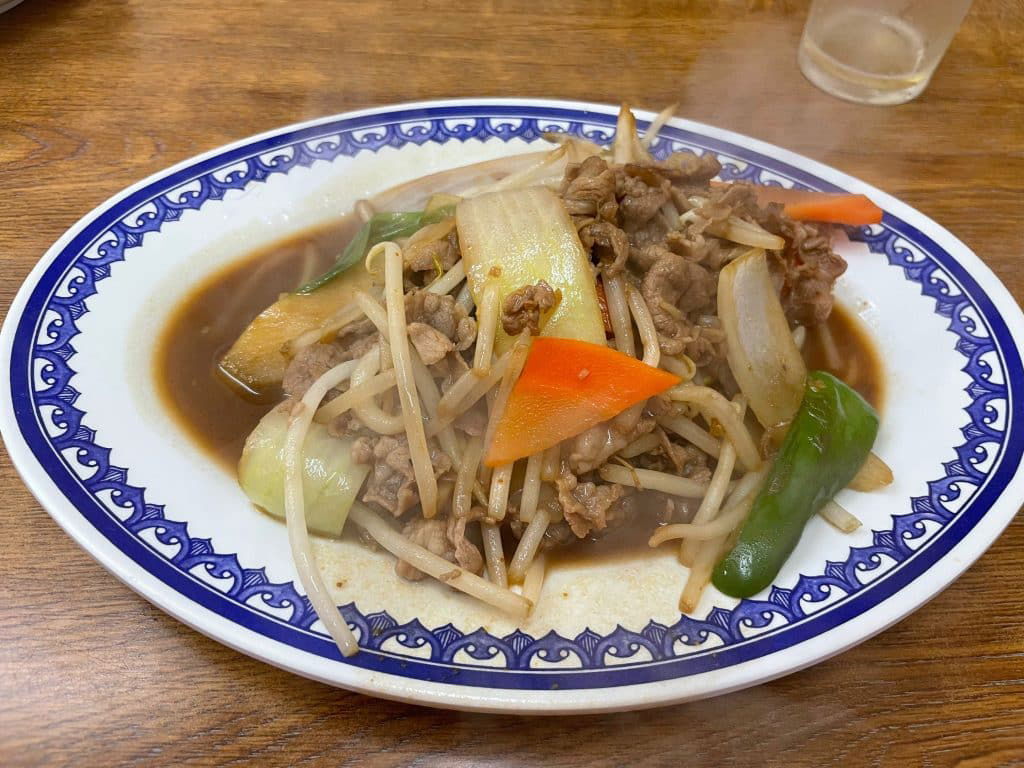
I decide on the Jingisukan (Gengis Khan), “a grilled mutton dish that is cooked on a convex metal skillet alongside beansprouts, onions, mushrooms, and bell peppers, and served with a sauce based in either soy sauce or sake.” The dish is very popular in Hokkaido, and I rarely see it on the menu at local Chinese restaurants in Osaka.
After eating I realize that we are six minutes on foot away from our next destination, Anryumachi Station, so we decided to walk instead of going back to Hosoikawa Station and waiting for the tram to arrive.
Anryumachi Station 安立町停留場
Anryumachi Station opened in 1911. This is a ground station on a newly established track, where single-sided platforms are arranged diagonally opposite each other on either side of a level crossing (staggered configuration). The platforms are low-floor and have a roof.
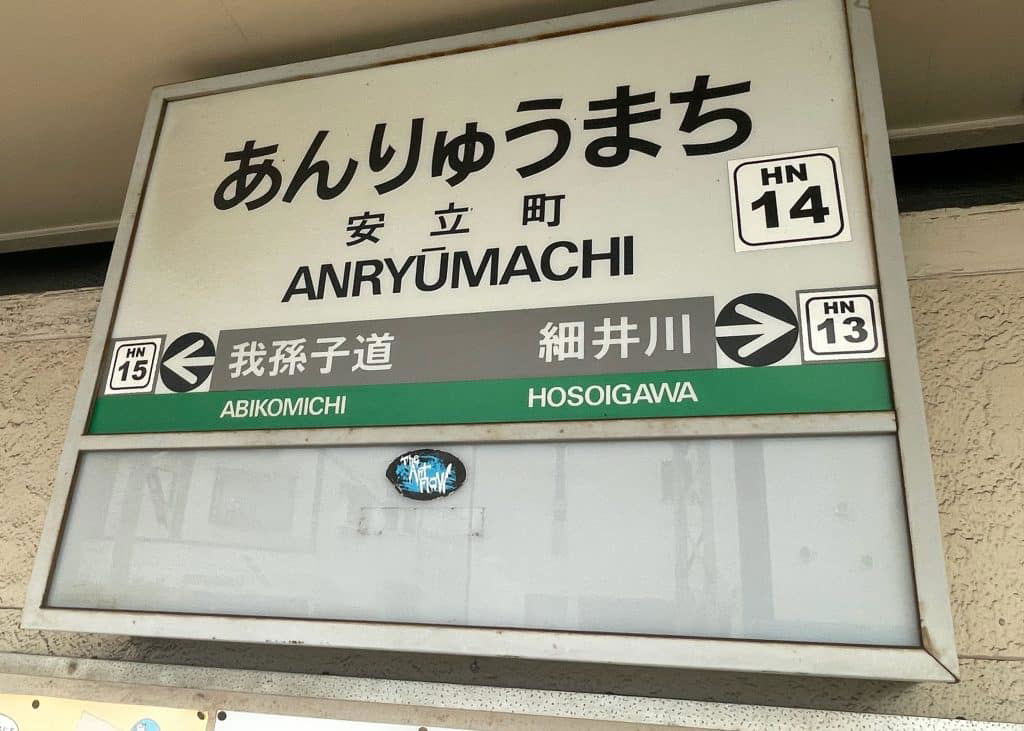
It started to rain just as we arrived at the station so we took shelter under the roof of the platform. I notice a man riding a bicycle holding an umbrella in his hand. On the other side of the tracks, which are covered in grass, an Mo701 series train leaves the station. These little moments capture the distinctive charm of riding the Hankai Line when there is no rush to get to your destination.
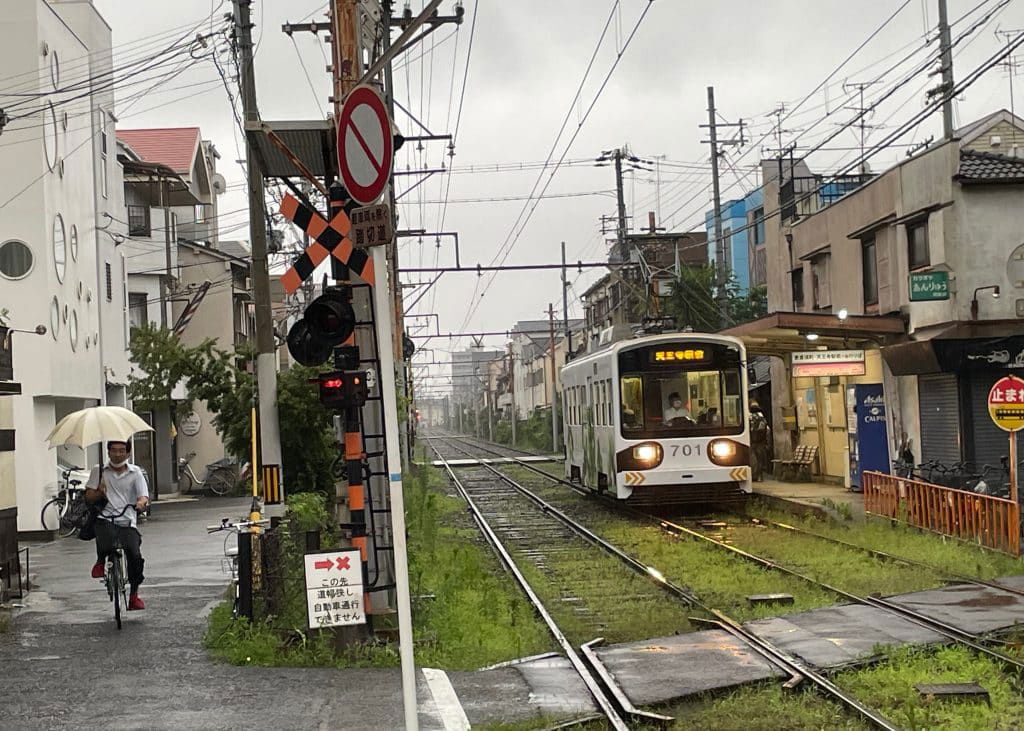
Anryu Shopping Arcade 安立商店街
Address: Anryu, Suminoe Ward, Osaka, 559-0003.
Although the station is located in Sumiyoshi Ward, Anryumachi is actually located in Suminoe Ward. The area has an historic feel with the Kishu Kaido running through its center. The Kishu Kaido is historic road that connected Osaka with what is now Wakayama. The road was an important route for pilgrims traveling to Sumiyoshi Taisha Shrine. Over time, the shops along this route have evolved into a shopping street, known as Anryu Shōtengai, which still retains a nostalgic atmosphere.
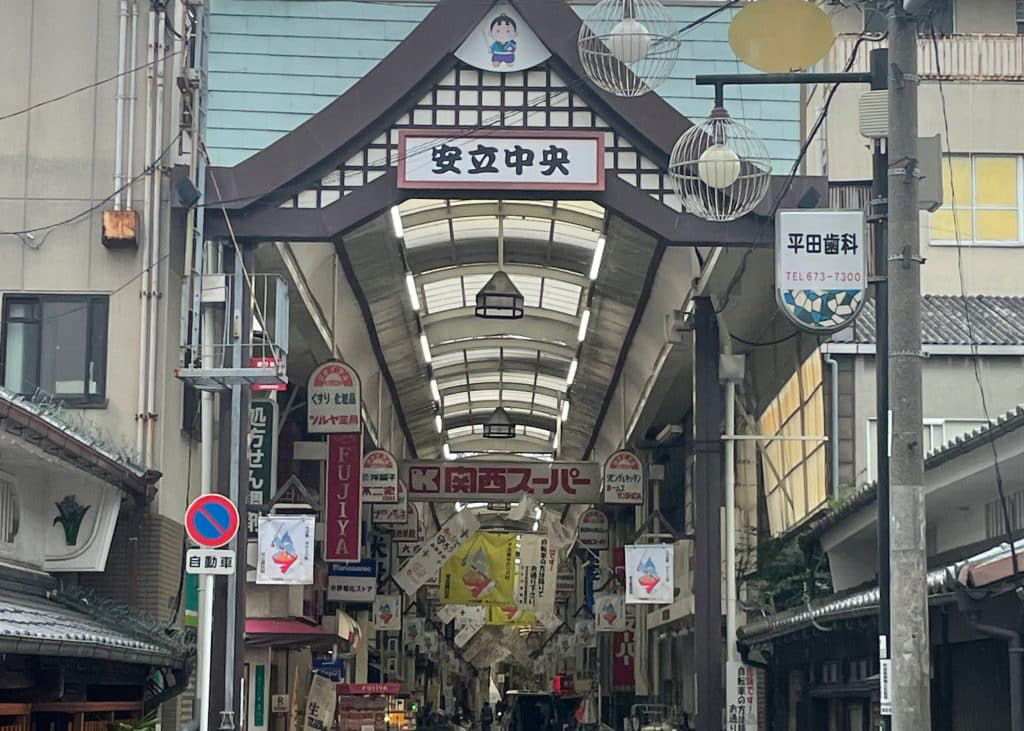
I really enjoy exploring these old shopping arcades in downtown Osaka, but there doesn’t seem to be many shoppers walking around at this time. As the population rapidly declines, I wonder how many of these shotengai will survive another decade. The central entrance of the arcade has several well-known shops such as the supermarket chain Kansai Super and Fujiya, a sweets and confectionery company that is famous for its mascot Peko-chan.

As we walk further down we come across older local businesses like Yoshii Fruits Shop, which looks like something out of a painting, even though most of the shelves are empty, save for a few boxes of oranges and apples out front. A lonely watermelon the size of a basketball sits on a crate in the background. The owner, an elderly gentleman is seated in a narrow both on the left hand side of the shop that sells tobacco products.
Super Galaxy Bookstore 大ギンガ書房
Address: 3 Chome-6-29 Anryu, Suminoe Ward, Osaka, 559-0003. Tel: 06-6615-9424. Open: 11:00-18:00. Website
I stop in my tracks when I come across Super Galaxy Bookstore. Now this is my kind of place! It’s packed with old books, manga, records and assorted toys and sports memorabilia. Many visitors to Japan are practically financing their next trip by scouring used shops for merchandise to resell such as vintage Nintendo cartridges, anime figures and vinyl records with the obi intact. Most of the key shops in Namba and Umeda been picked clean, but this shop is located in an out-of-the way shopping arcade where few tourists ever venture.

I have no idea if there is anything of value in this store; it’s just nice to browse old pop culture items. I spot what looks like a Hanshin Tigers Nike sneaker, but I could be wrong. Next to it is a Tigers “stand light,” but I’m not about to take it out of the box to see how it looks. There are stacks of Urusei Yatsura and One Punch Man manga, neatly wrapped in cellophane for those interested in buying an entire volume.
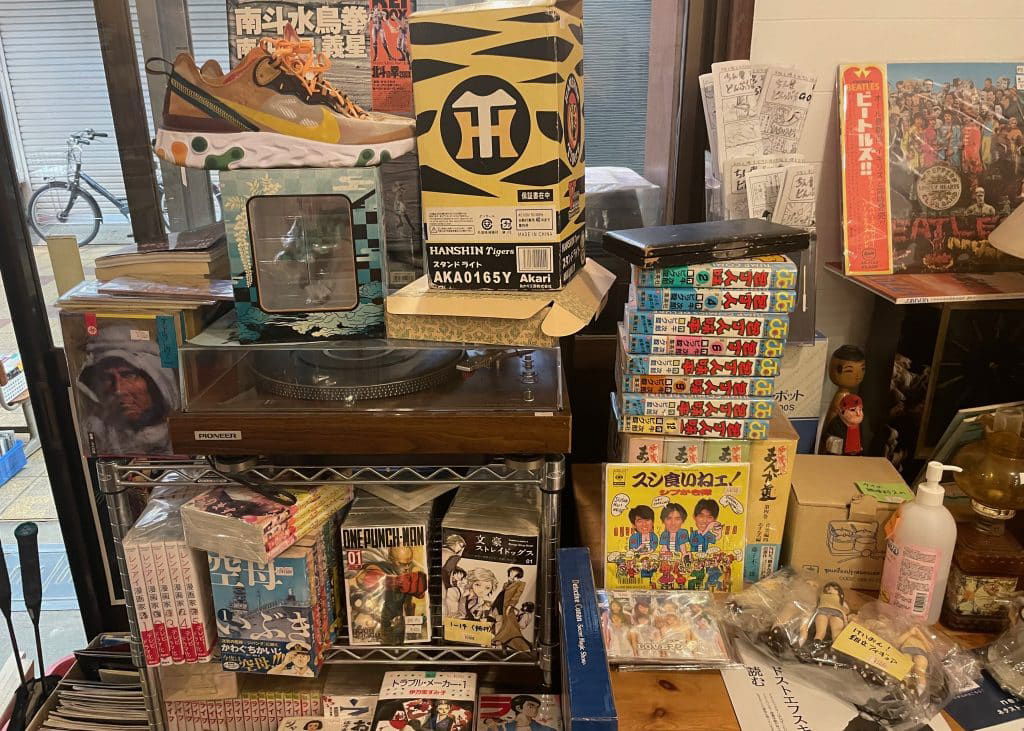
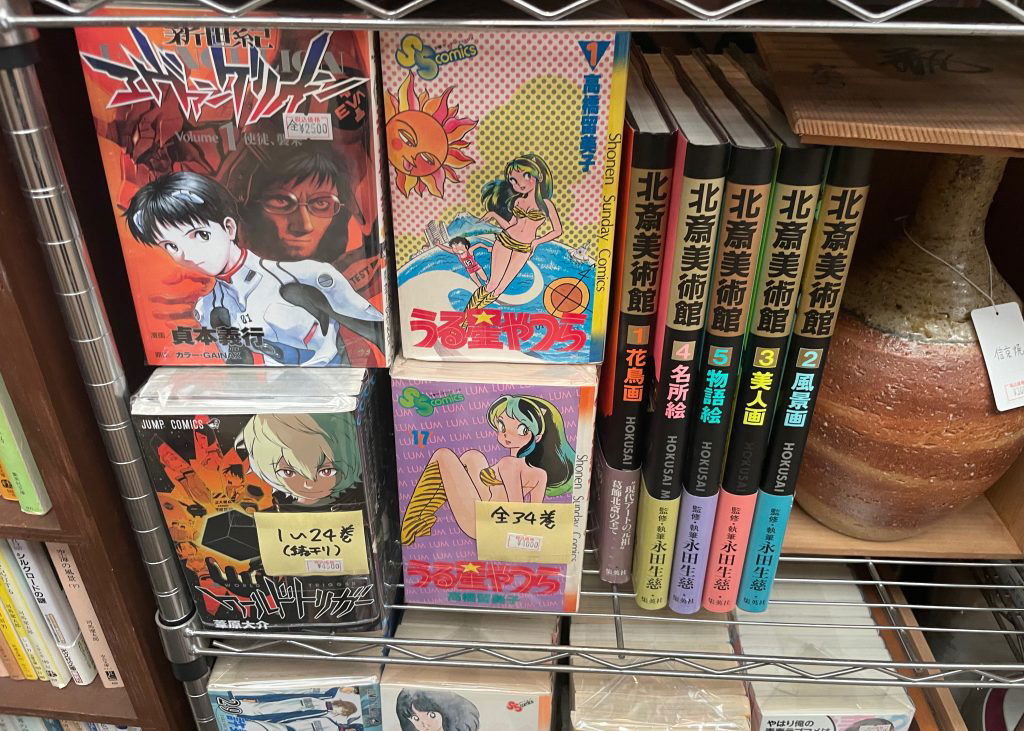
Vintage Vinyl for Sale
I notice The Beatles Sgt Peppers Lonely Hearts Club Band with an obi, but I don’t feel like pulling out the phone to check the value on Discogs like so many people do these days. I’m just going to pull one album out of the box to photograph for this article, no matter how crappy it may be. I reach in and grab..a Cheryl Ladd LP. Who even remembers that the replacement for Farrah Fawcett Majors on Charlies Angels released an album? That being said, it has to be better than the *four* CDs that Alyssa Milano of Full House released in Japan.
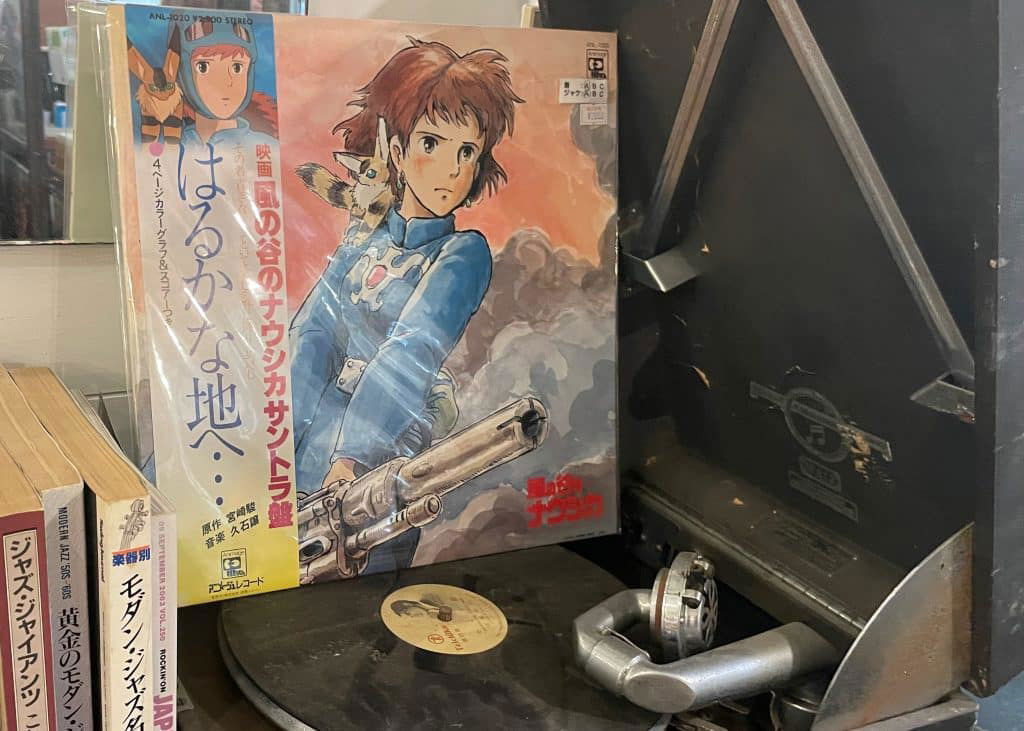
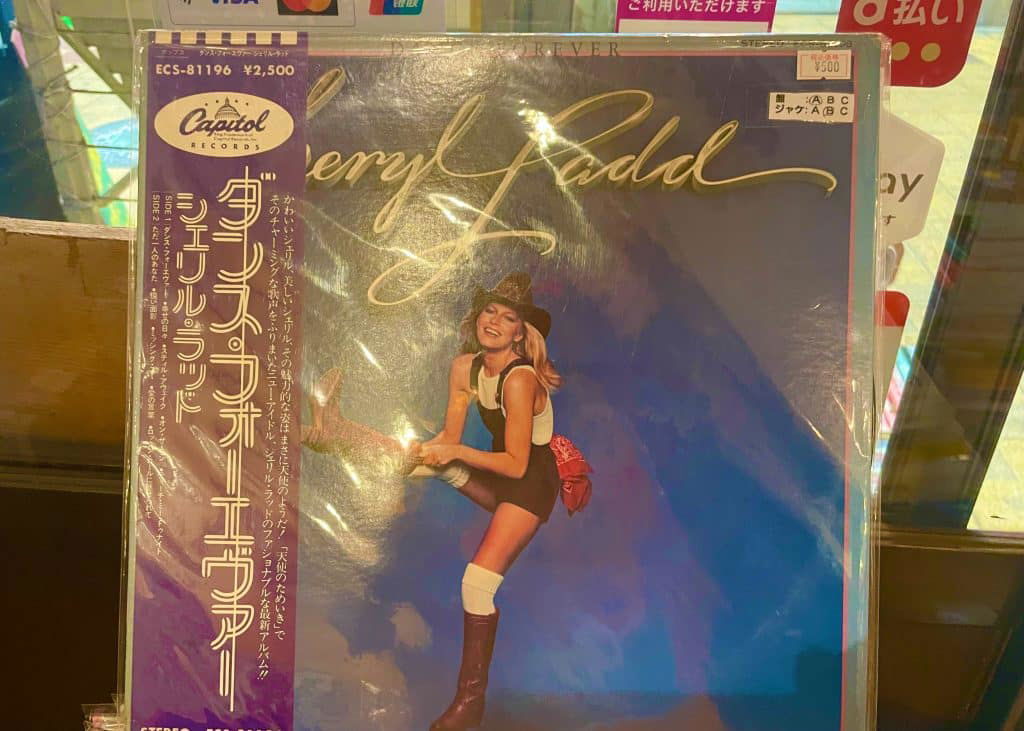
Enka Cassettes
I spot a box of enka cassettes in a worn cardboard box out front. They are only 100 yen each and some of them are still shrink wrapped in the original plastic. After shuffling through the selections, I decide on two Osaka-themed songs: Osaka Mambo by Maki Yuko and Sukiyanen Osaka by Naniwa Koyuki. These might come in use if I decide to write an article of Osaka-themed enka and pop songs.

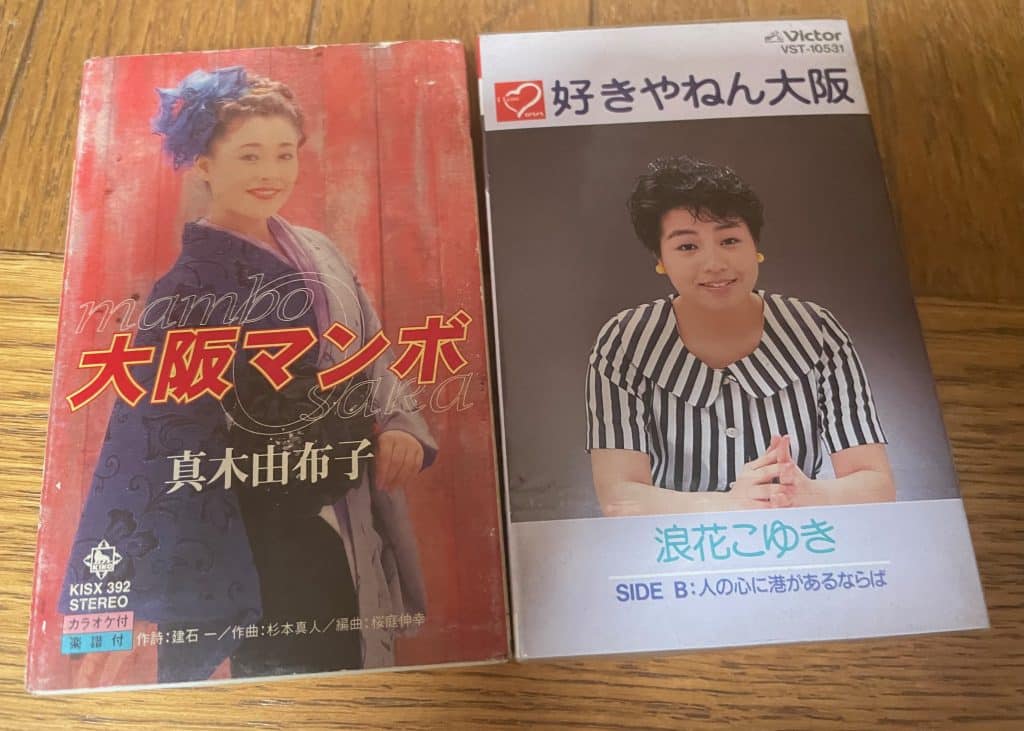
Abikomichi Station 我孫子道留場
Abikomichi Station is the last stop in Osaka on the Hankai Line, and passengers can switch here to go on to Sakai. Trams originating from Tennoji-mae on the Uemachi Line often change crew members here. I take a photo of the red Mo502 street car, manufactured in 1957, bound for Tennoji-mae Station.
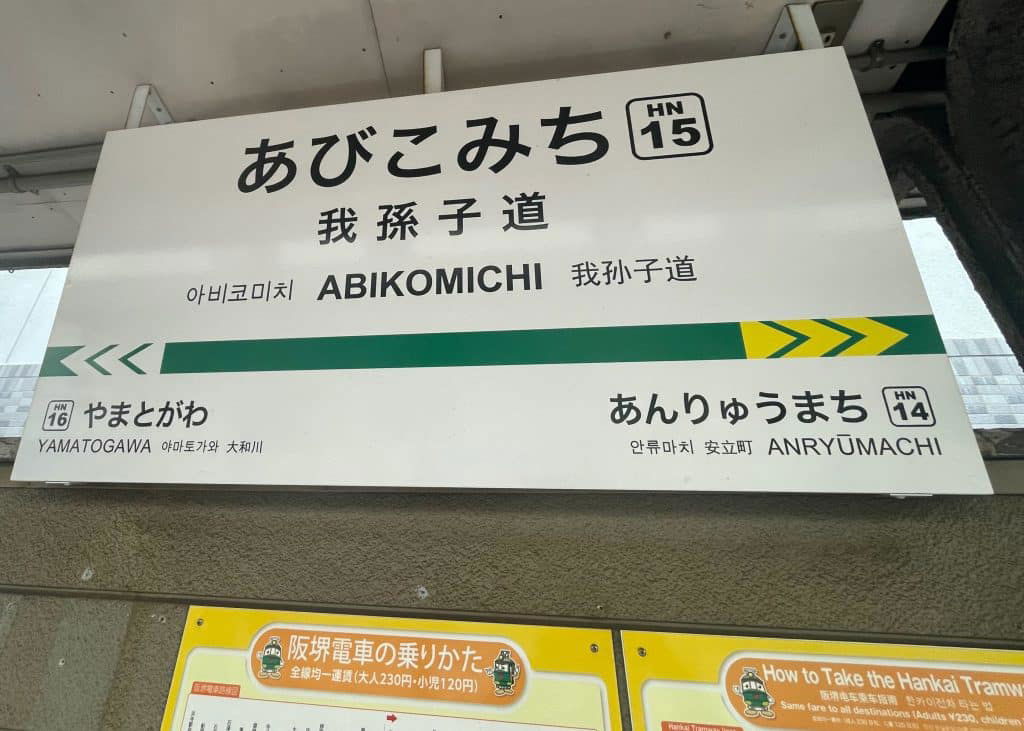
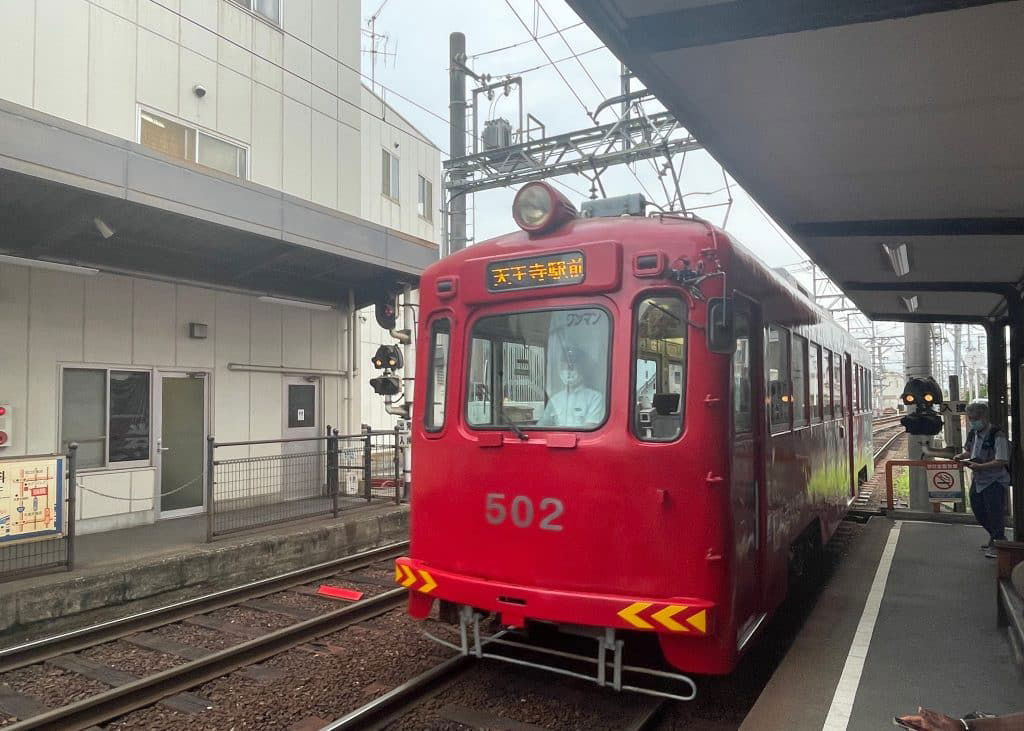
Hankai Electric Railway Abikomichi Garage (阪堺電気軌道我孫子道車庫)
Address: 3 Chome-14-72 Shimizugaoka, Sumiyoshi Ward, Osaka, 558-0033.
Abikomichi Station is also the of the Hankai Electric Railway Abikomichi Garage (阪堺電気軌道我孫子道車庫), where trains like the classic Mo161 series are kept when not in use. According to Google Maps it is 5 minutes on foot so we decide to see it for ourselves. We walk down a street that has several old houses with impressive architecture. At the end of the street I see steps that would make Rocky Balboa proud. From afar, they look like the fabled Stairway to Heaven, but in reality these steps just lead to an ordinary road with cars whizzing by.
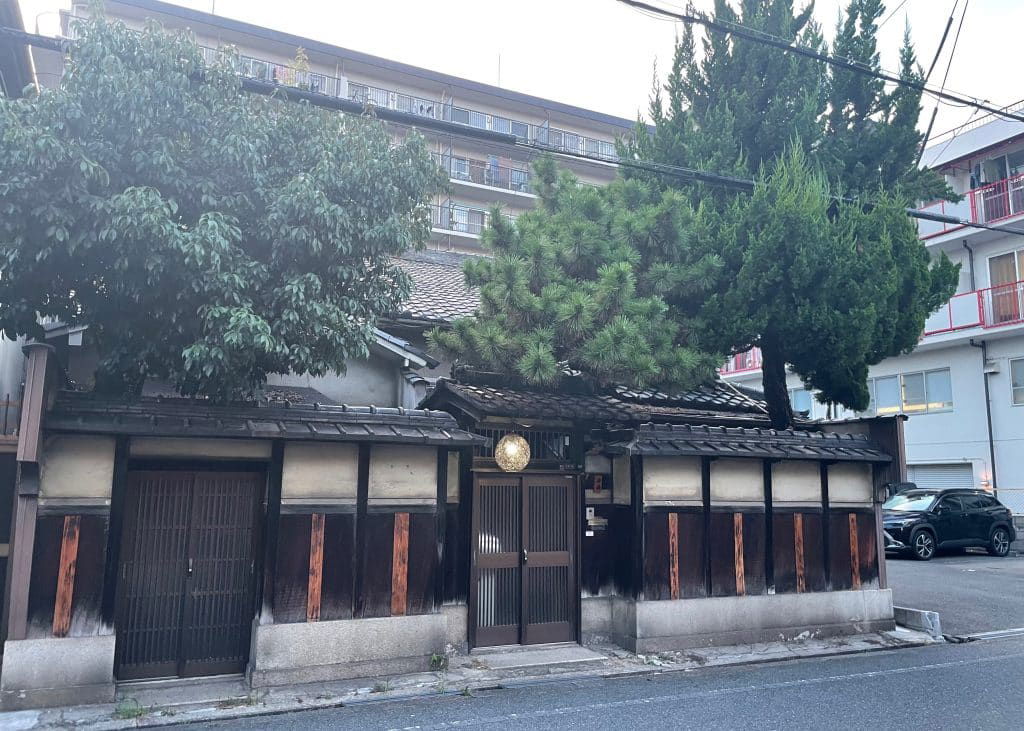
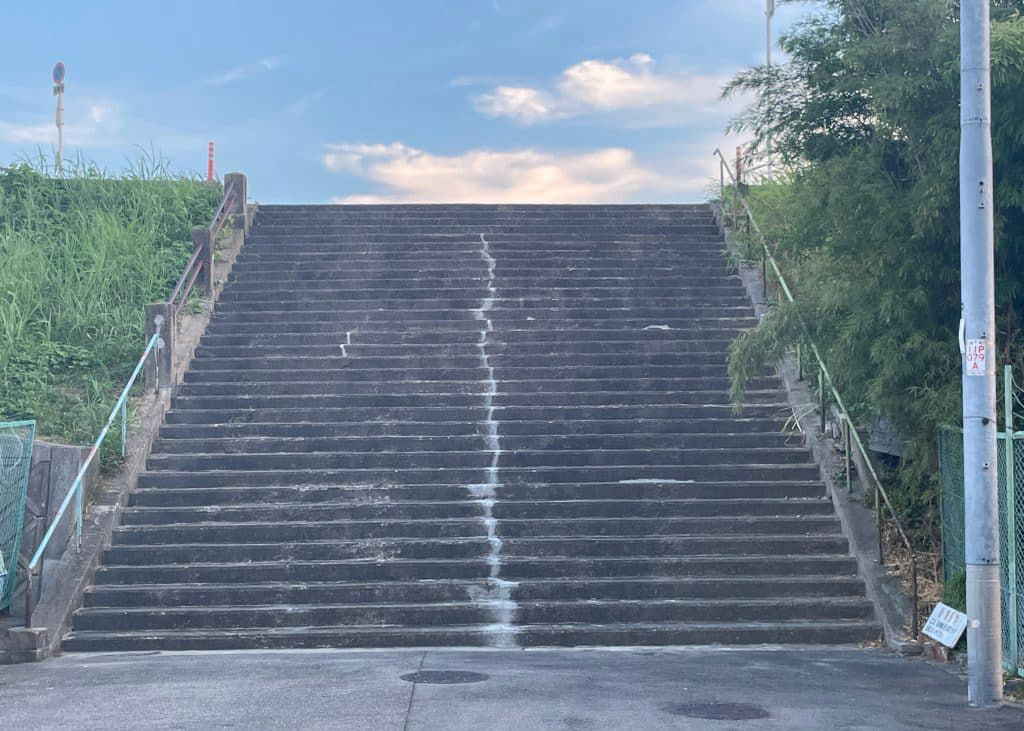
The gate of the railway yards is open, so we enter the grounds. I’m glad I’ve studied up on my tram history because I can now identify the models by the year they were manufactured. I spot the Mo164 from 1930 we rode on, but am surprised to see that the Mo163 from the same year is next to it. I thought they scrapped it years ago.
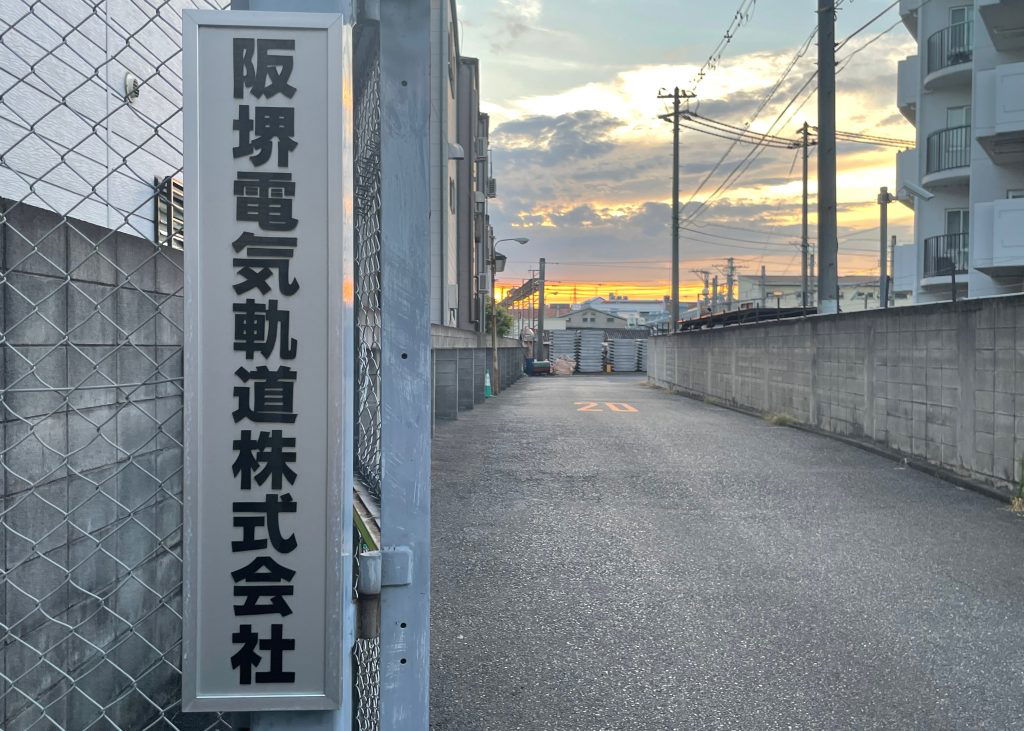
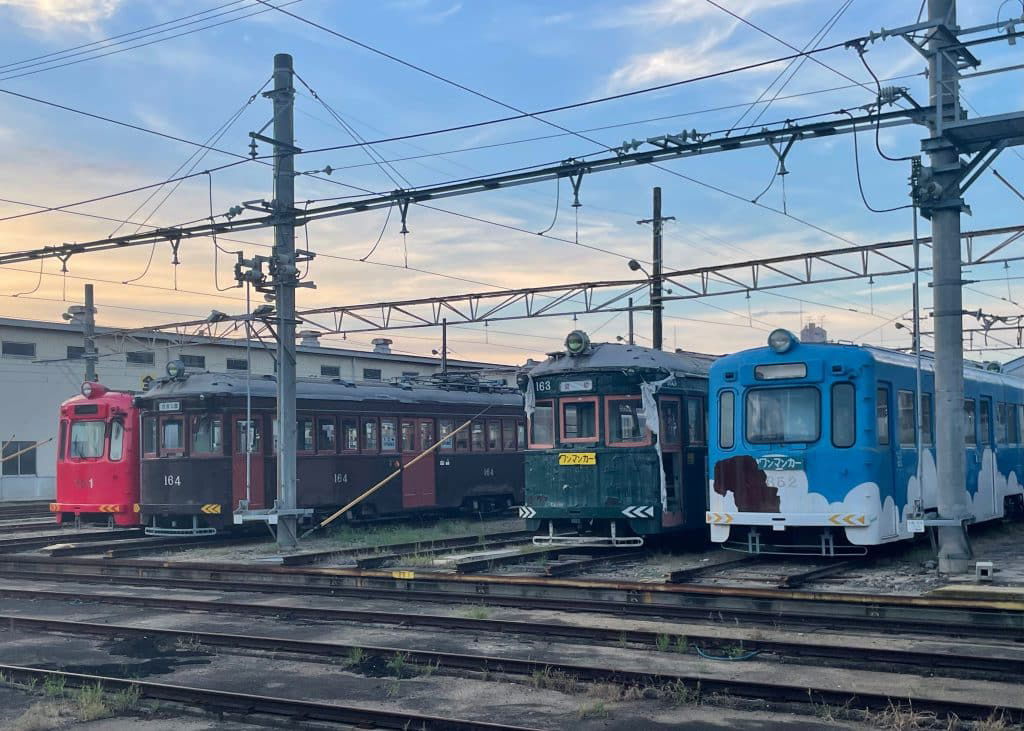
The Mo351 and Mo353 cars on either side from 1962. The Mo352 car notoriously derailed in 2016 and was taken out of service permanently. All of this tram trivia is making me hungry, and it’s time to leave. I’ll come back when the Hankai Railway holds an official event here. Earlier this month they hosted a gourmet festival with food trucks.
Barhopping around Abikomichi
We look around for a place to sit down and grab a quick drink, but nothing seems to be open other than a nearby convenient store. It feels like we’ve hit the proverbial end of the line. During the day, the area resembles a ghost town, with abandoned houses and shuttered shops. I notice an old bicycle with encroaching vines. Having visited enough local stations in Osaka, I’ve learned that appearances can be deceiving in daylight.
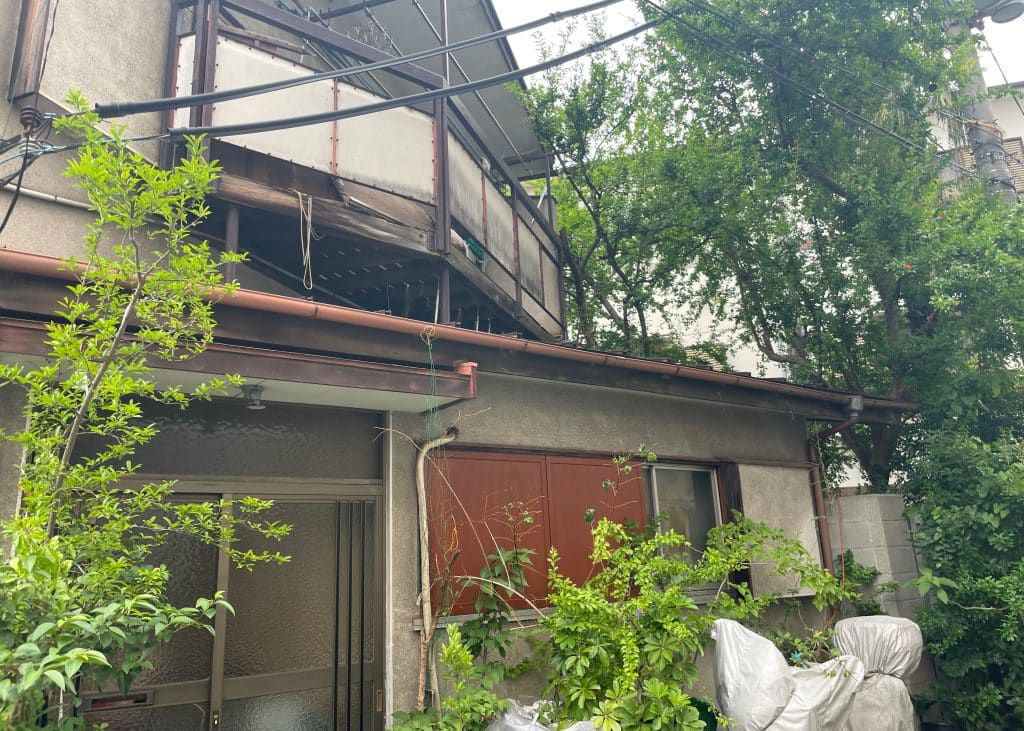
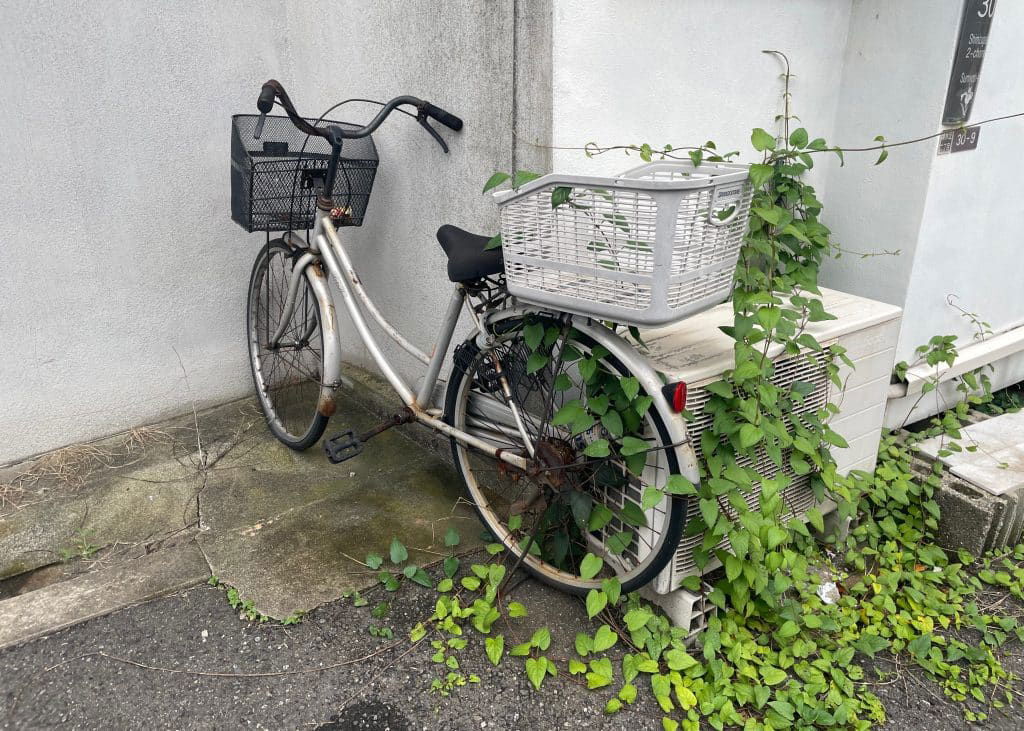
As it turns out, the area truly comes alive at night. There’s a cool vintage karaoke kissaten called Nonki that looks like it dates back to 1988. We spot a trendy yakitori restaurant called Sakuraya that looks promising, but we decide to keep walking, hoping to find a place with more of a local, neighborhood vibe.
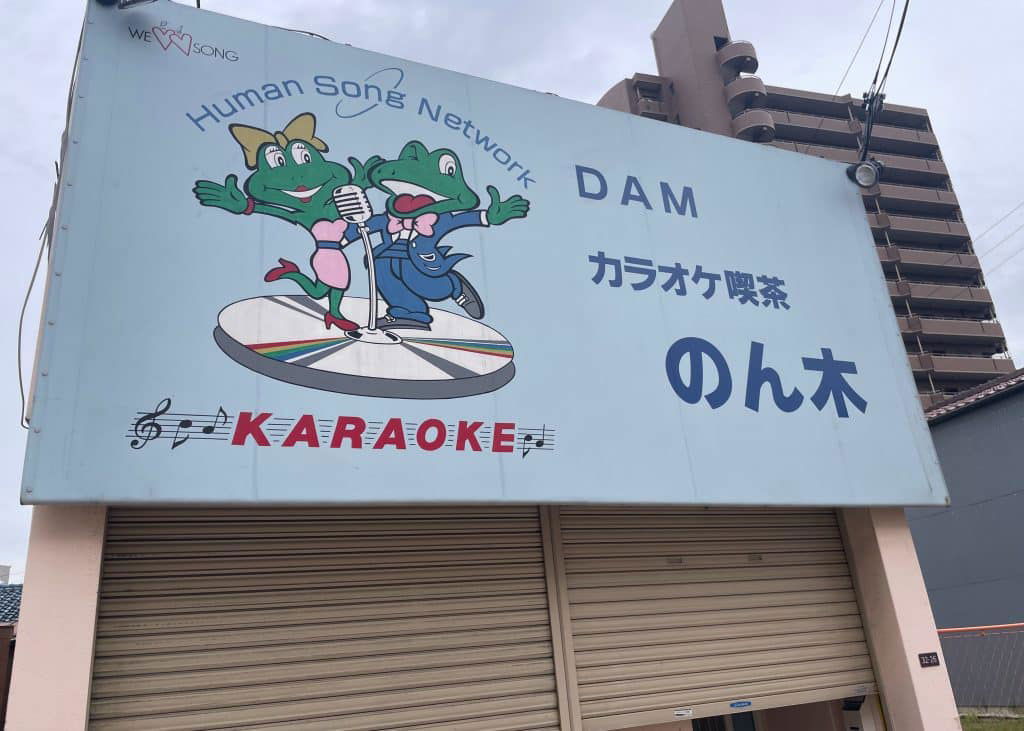
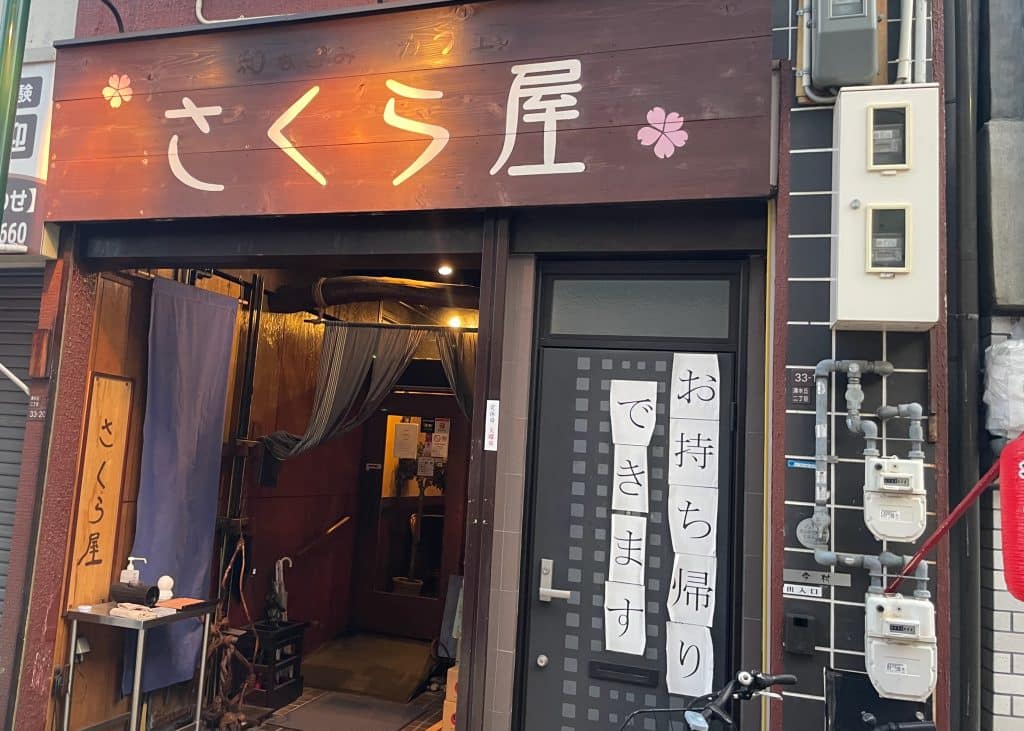
Bento no Moriya 弁当のもりや
Address: 2 Chome-29-3 Shimizugaoka, Sumiyoshi Ward, Osaka, 558-0033. Tel: 06-7181-0483.
We find a small restaurant that is open on side street called Bento no Moriya. I notice a flier for a missing parakeet. Lost pet notices never fail to break my heart. One of the owners happens to be out front so I wish her luck in finding the bird. It seems like a friendly spot so we decide on a whim to go inside.
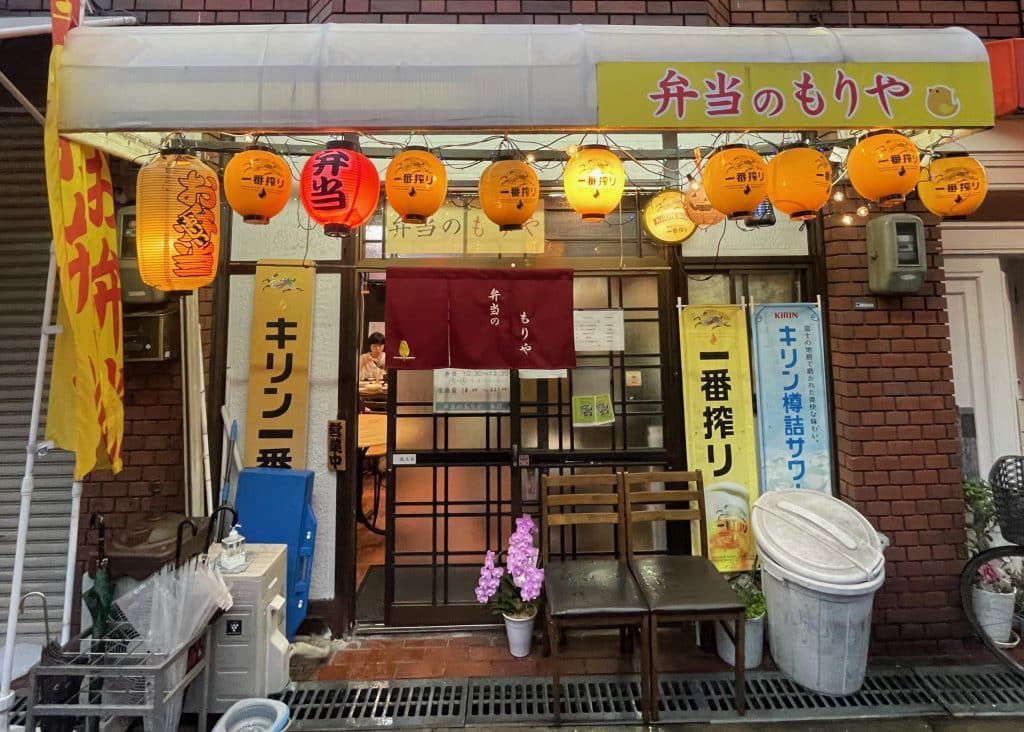
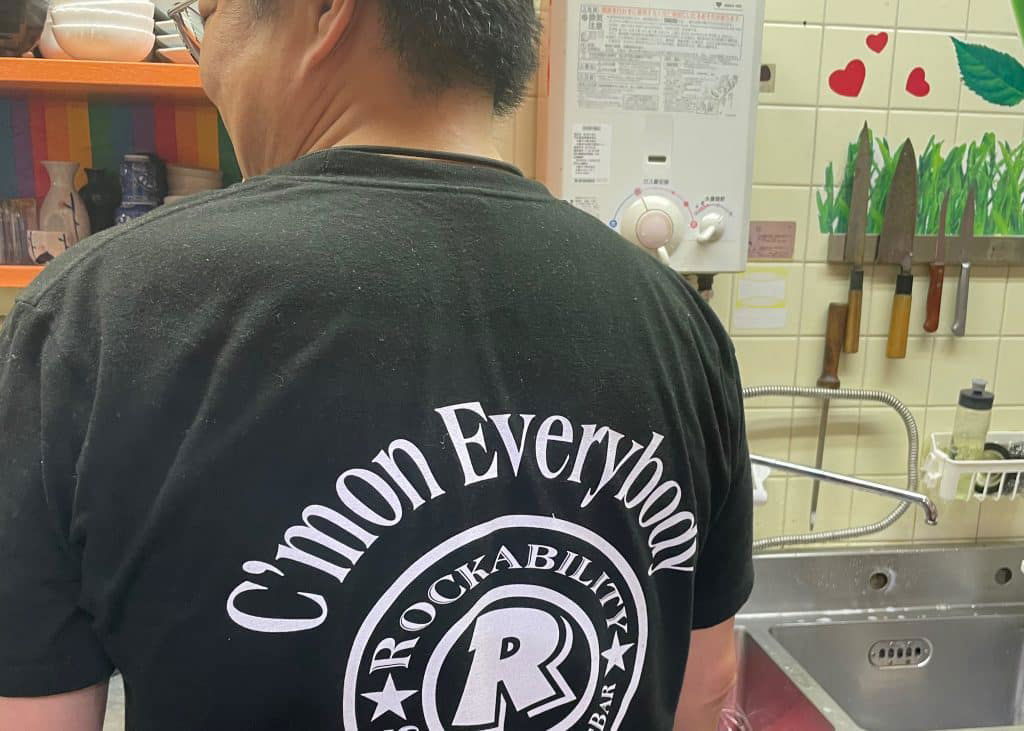
The master of Moriya is wearing a shirt advertising a local bar called Rockability. He tells me that it has a stage for live shows and we have a pleasant chat about Japanese rock bands. I really enjoy seeing live music in bars, or just talking about music with other fans, so I make a note to visit Rockability sometime in the near future, even though its a bit of a trek from my house.
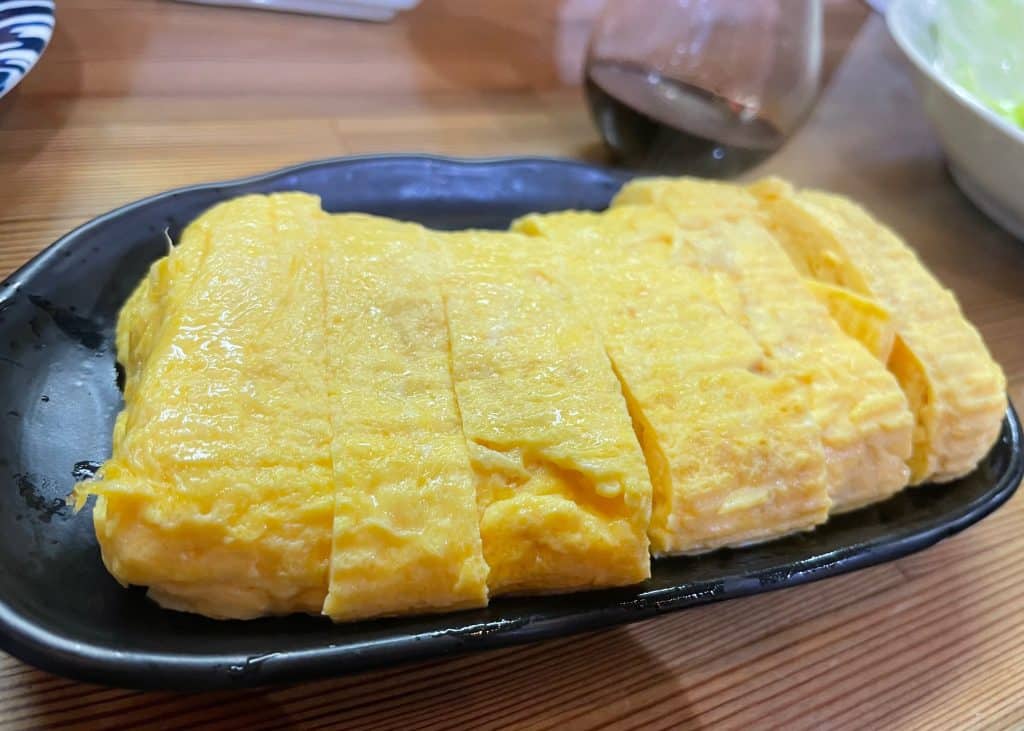
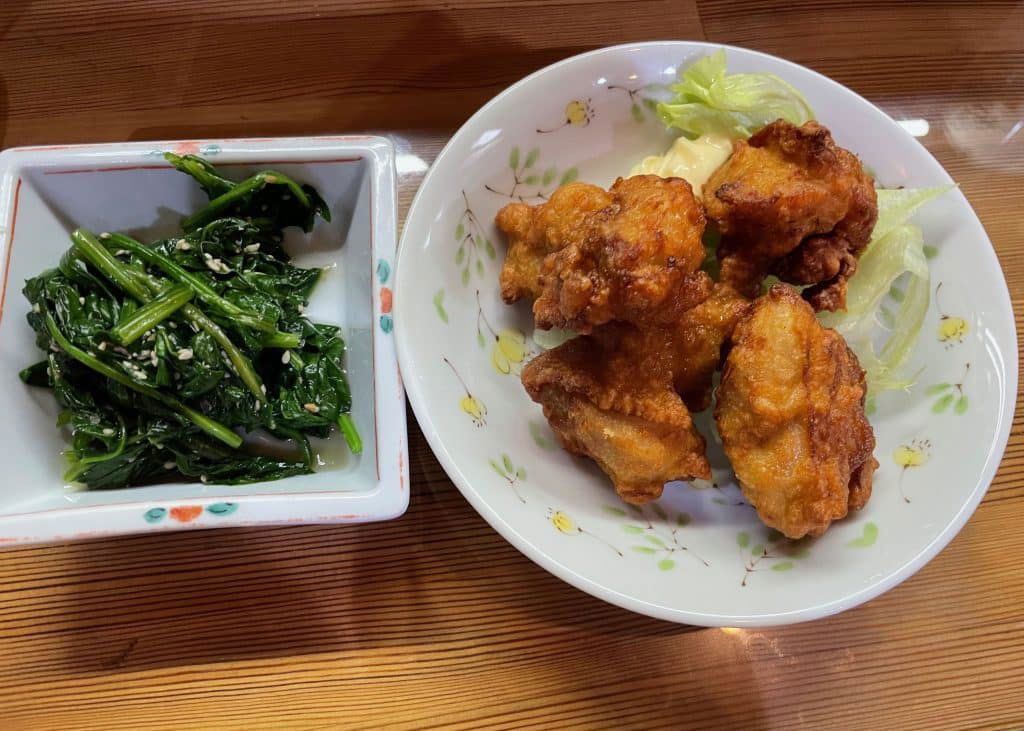
We order dashimaki tamago, karaage fried chicken and a side dish of ohitashi, boiled spinach seasoned with soy sauce and fish stock. You usually can’t go wrong choosing these standards from the menu in Osaka from a local Mom and Pop shop, and we are not disappointed.
George’s Bar and Cafe
Address: 3 Chome-14-72 Shimizugaoka, Sumiyoshi Ward, Osaka, 558-0033. Tel: 06-7221-0842. Open: 5PM-3AM.
We planned on heading home, but on our way to the station we notice an interesting neon sign for a place called George’s Bar and Cafe. We really didn’t eat much at the last place and I for one am still hungry after walking around all today, so we head inside. The drink menu boasts an impressive selection of whiskey and cocktails, and I’m happy to see that they carry Belgian ales like Duvel and Chimay.
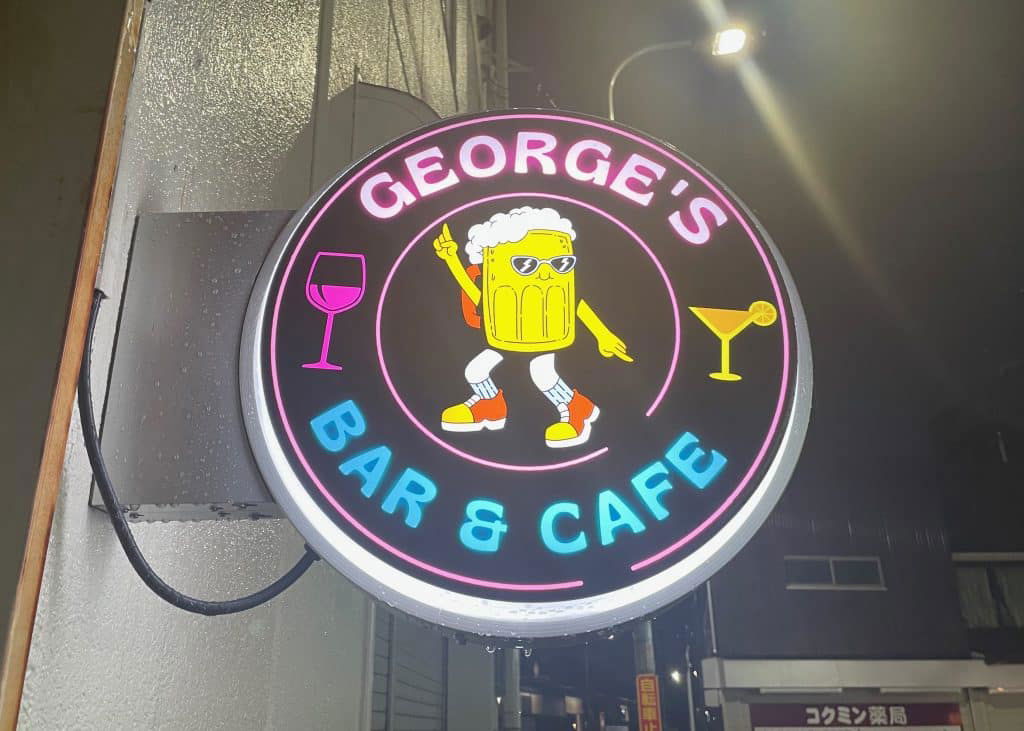
Keith Bazzle: Osaka Nightlife Legend
The manager of George is a stylishly dressed American named Keith. He’s joined behind the bar by a young woman from Hong Kong. He tells me George’s Bar and Cafe only opened a few months ago in April. The owner, George, is from the Netherlands, and most of the customers are locals from the neighborhood, along with a few foreign regulars who pop in from time to time.
After chatting with Keith for a few minutes, I realize we’ve met before—he’s none other than the legendary Keith Bazzle, the former owner of Southside, a really cool bar that used to be on the second floor of a building in Shinsaibashi. I had visited Southside a couple of times over a decade ago when C.C. Haydel, the former owner of Bistro New Orleans, was doing pop-ups at various bars in Osaka before opening his own restaurant.
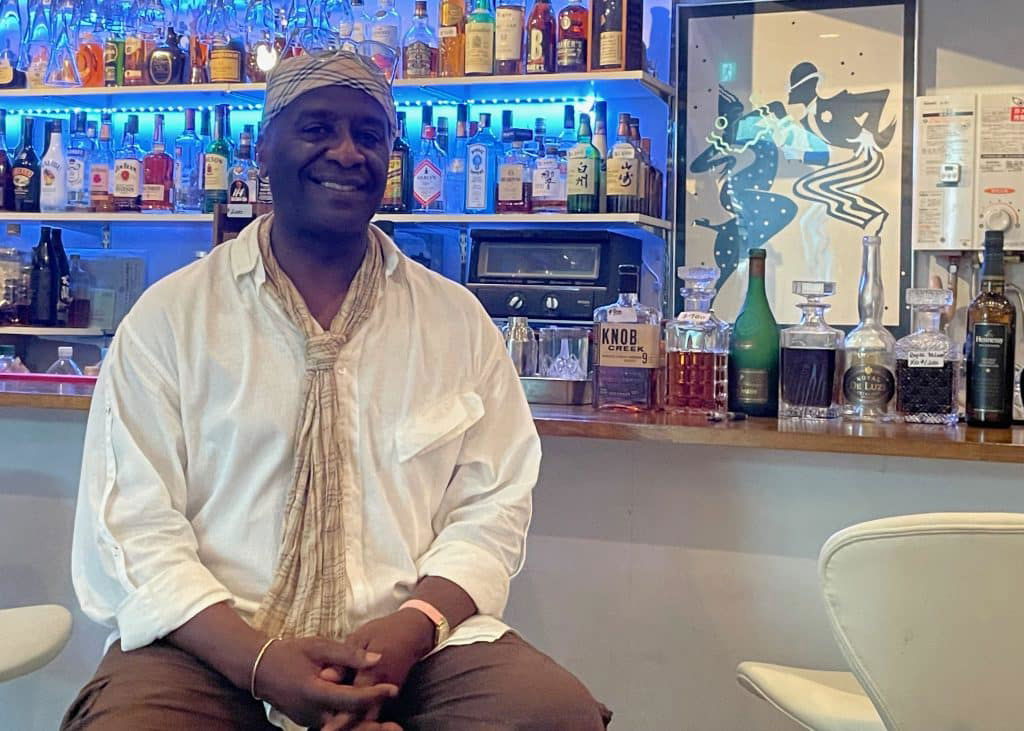
Keith first arrived in Japan during a stint in the Navy. After his service, he worked in Alaska and Hawaii, where he made many Japanese friends. He then moved to Tokyo in 1990, but quickly realized he preferred Osaka. Keith opened Southside in the early 2000’s and ran the bar for 12 years. After Southside closed in 2018, Keith briefly moved to Los Angeles, but returned to Osaka a couple of years later and never looked back.
Comfort Food from Home
The food menu has comfort food from home like cheese nachos and spaghetti. Texas Hot Dog, which comes with a generous topping of avocado. My wife decides to split a pizza with me. I was expecting the typical mini pizza found in most bars, but this one was thick with cheese and certainly enough for two people.
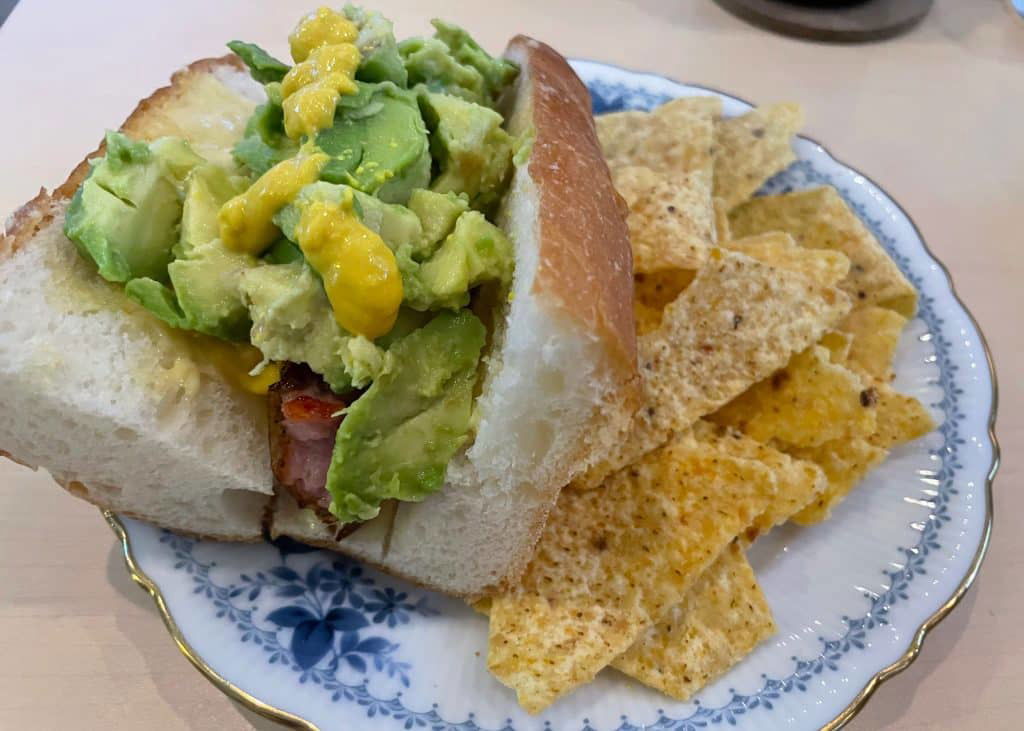

Most customers come to a place like George’s talk to staff, so they don’t want them tied up preparing elaborate dishes. The food was simple, delicious and arrived quickly. What more can you ask for? They also play an excellent selection of music, and take requests. We had a great time on our first visit and I planned to come back soon.
Return to George’s Bar and Cafe
I end up returning to Abikomichi much sooner than expected. Keith messaged me on LINE to let me know that my wife had forgotten her new hat. What better reason to step out of the house on a Friday night? This time I intend to stay much longer so I can get the full experience of hanging out at George’s. Hopefully I’ll get to meet some of the regular customers this time.

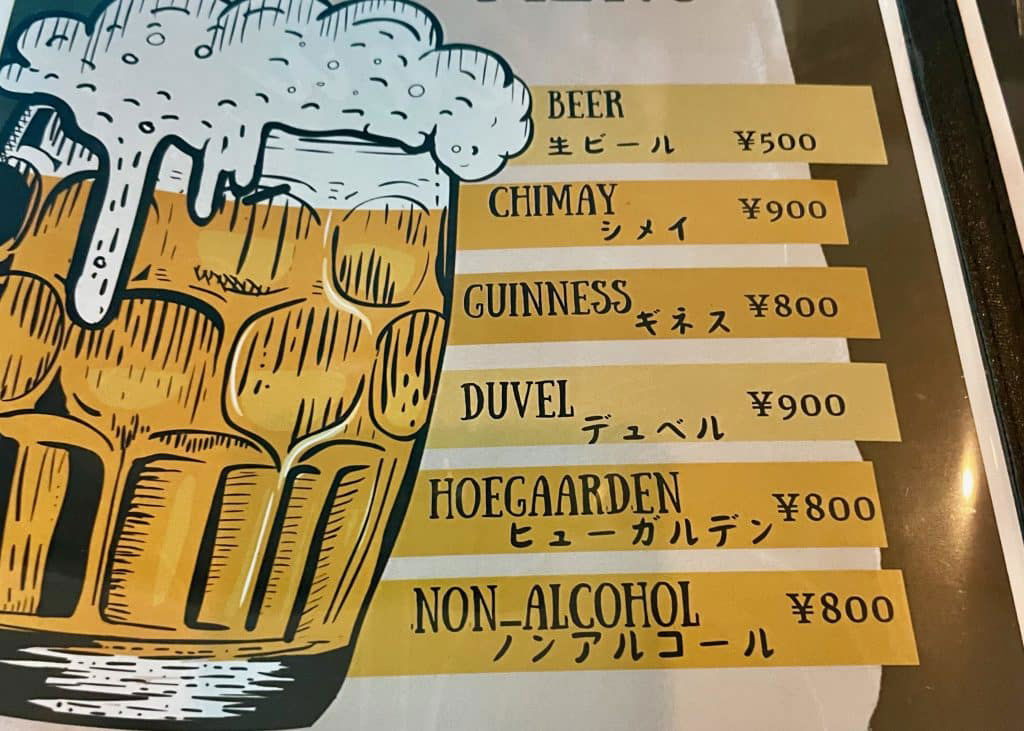
Speedy Delivery from a Regular Customer
Minutes after I sit down, a very friendly woman bursts through the door and hands Keith a present: a styrofoam take-out package of yakisoba that looks delicious. She tells me her name is Junko Yonago, and she owns a by the station called Tatton-Tei that also specializes in gyoza, udon, chijimi and oden. I reply that I would love to visit her shop afterwards, but she lets me know that it has just closed for the day.
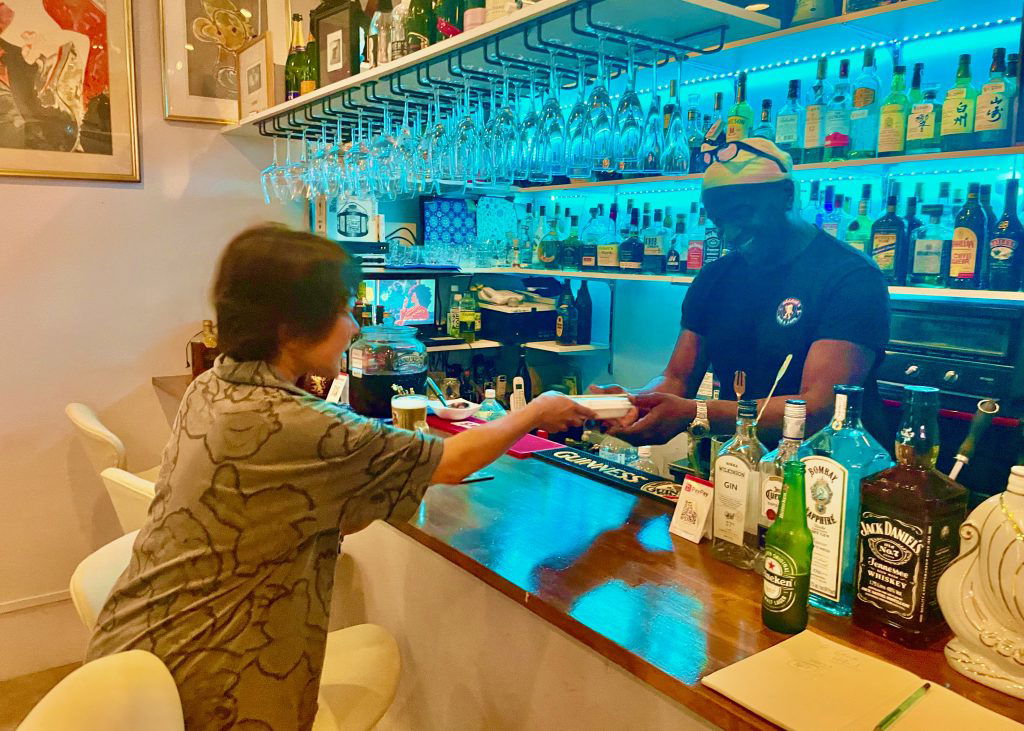
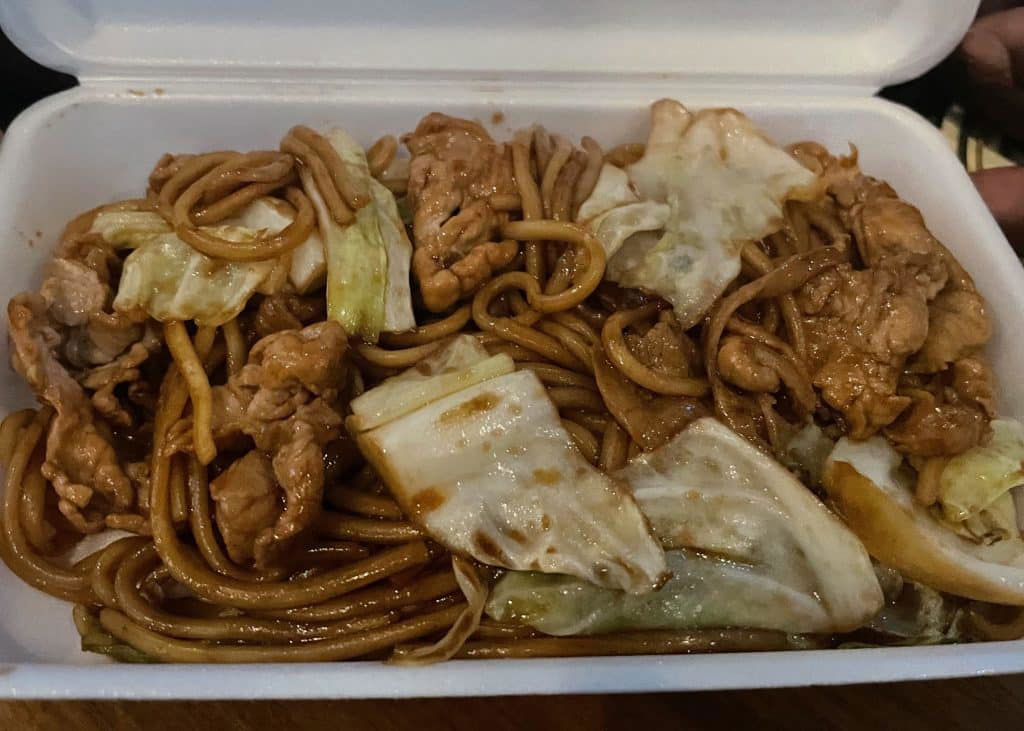
Junko said that has been to George’s almost every day after work since it opened in April 12th. After finishing her drink, she gets up from her seat and announces that she is going to bring gyoza over from her shop so I could try it, which I thought was a really nice gesture for someone she had just met.
A Quick Detour to Tatton-Tei
Address: 3 Chome-9-7 Anryu, Suminoe Ward, Osaka, 559-0003.
I realize that I better get a photo of Tatton-Tei before it gets dark so I follow Junko out the door even though I haven’t finished my first beer. Fortunately, the shop is just located just across the tracks on the Suminoe side, and takes less than a minute to get there. I snap the photo and return to George’s. When I first visited Abikomichi, I had no idea what to expect. Now I know about three good places to eat and drink nearby. I love learning about new places from locals, especially when they are drinking at the bar in the seat next to me.
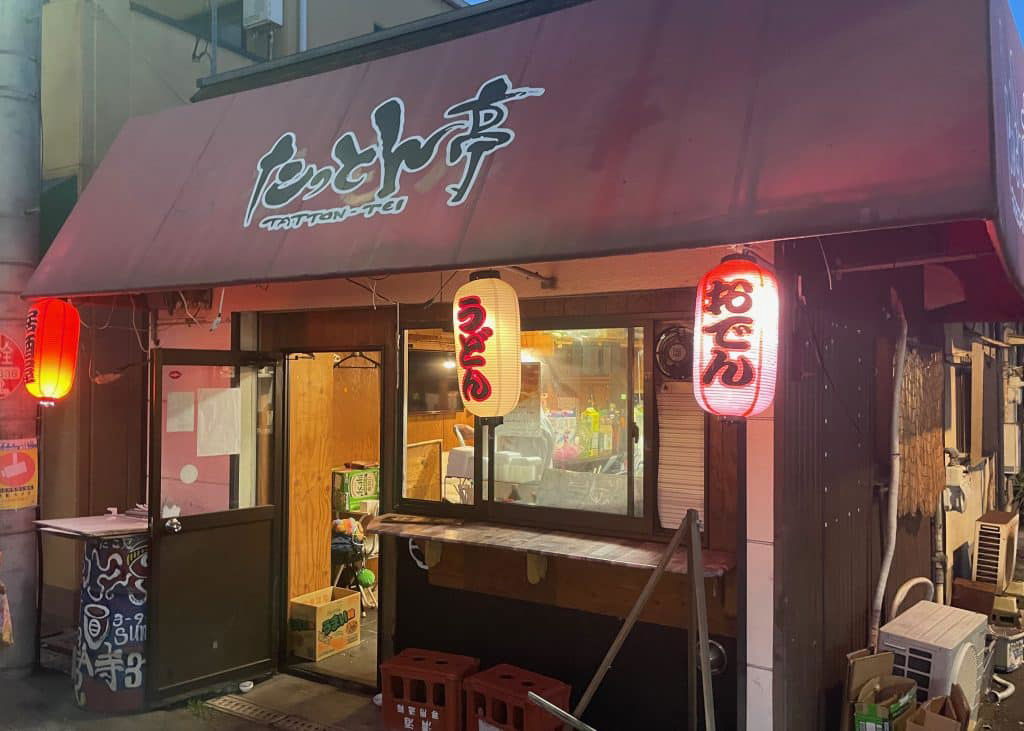

Junko brings the gyoza to George accompanied by a young man, and they sit down at the bar. I cannot wait to try the gyoza, and when I take a bite I am in heaven. The dumplings are juicy without being oily and have the perfect texture on either side: soft and crunchy. The flavor is so good that you can eat them without the usual dipping sauce. I compliment Junko on the gyoza, but she tells me that it was her son, Ren, the young man sitting next to her, who actually prepared them. He learned his trade by working at other restaurants in Osaka, and now he applies his skills to the family business. I can’t wait to go there and sit down properly and try their other menu items.
Meeting George and Gabi
I finally get to meet George, the owner from the Netherlands. He owns a recycle shop around the corner. He started his namesake bar after the previous occupant, a karaoke bar, closed down and the space became available. Then another longtime Osaka resident walks through the door: Gabi Zion from Senegal who used to run his own bar. George, Keith, Gabi and I talk about Osaka back in the 90s and mention a lot of nostalgic places that no longer exist such as Bar, Isn’t It, Zombie Palace, Canopy, Wadada and Glenns. Before the Internet, it seemed like all the foreigners in Osaka knew one another, now everything happens on social media. I really miss those days sometimes.
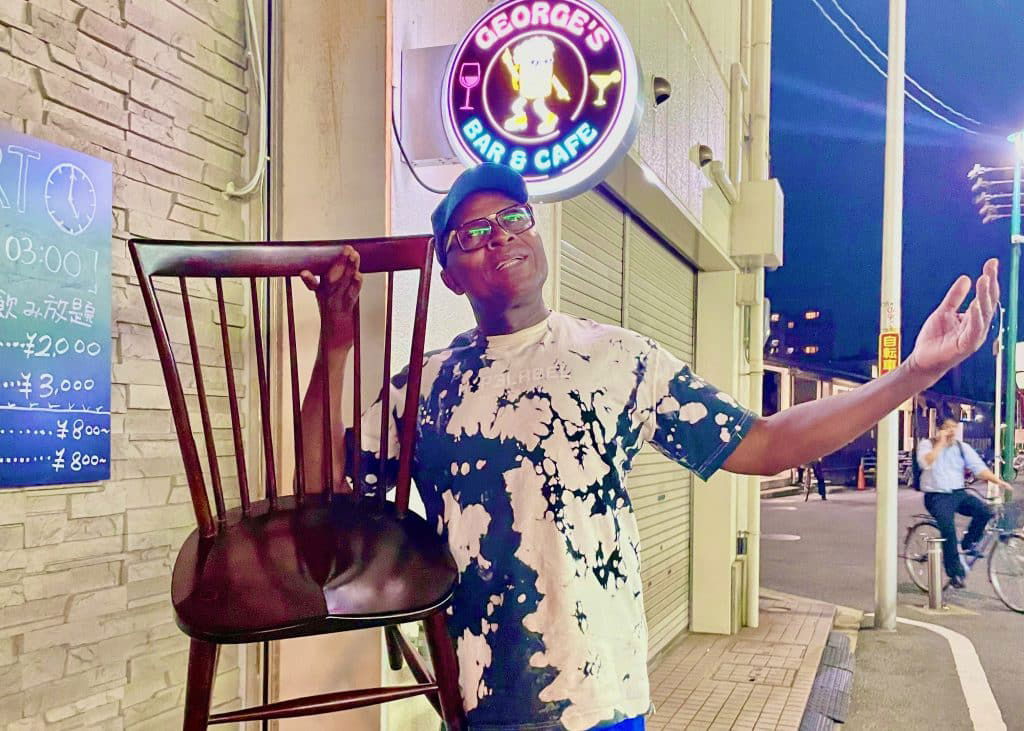
A Sense of Community
The bar is starting to fill up. Junko and Ren are still here. A young woman named Miu comes in. She tells me she’s really proud to be from Sumiyoshi and loves her community. I was particularly impressed by how the staff Bar George has created an atmosphere in which Japanese and English seamlessly blend, making conversations engaging and inclusive, regardless of language ability. Some Japanese customers are fluent in English, while others don’t speak a word, yet the lively banter and laughter have been nonstop throughout the three hours I’ve spent here.
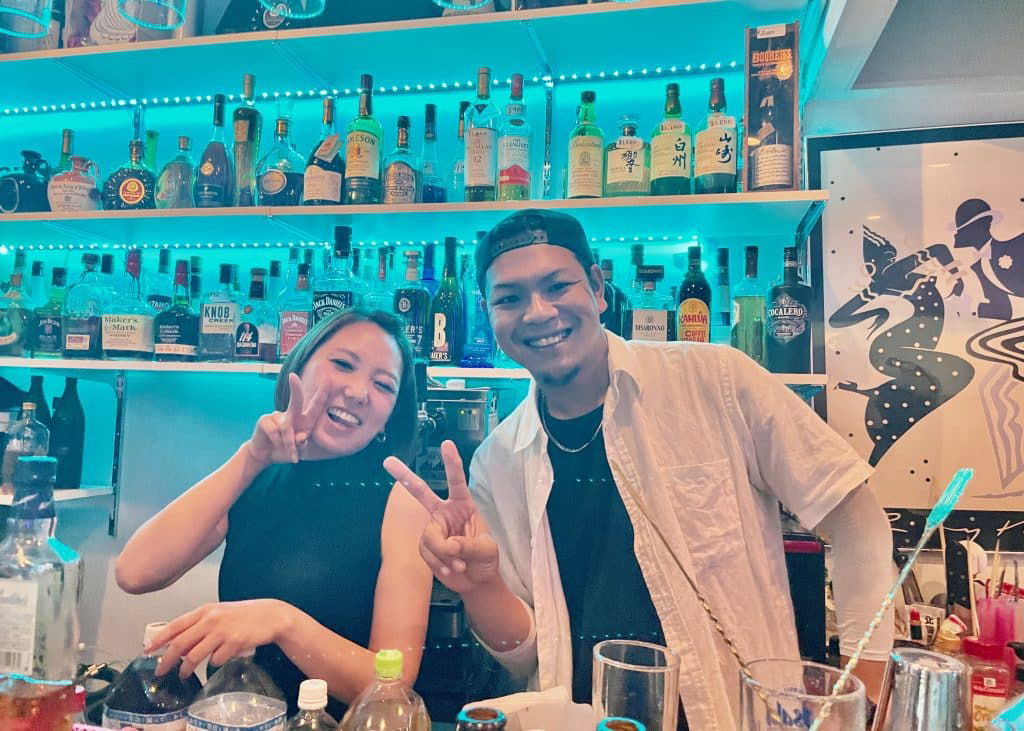
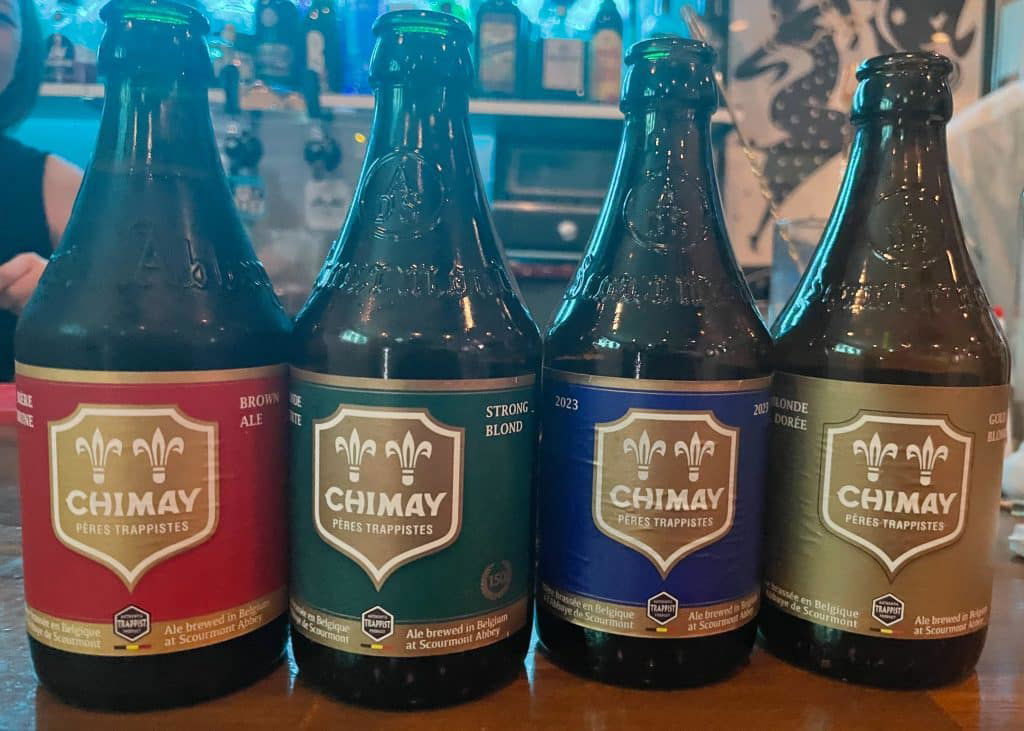
When Keith’s shift ends, he swaps places with two young Japanese employees, Ayumi and Hama, and takes a seat at the bar. It’s getting late, and I realize I need to start thinking about catching the tram home. I began the evening with a Heineken at 6:30, and now, at 10 PM, I’m on my third bottle of Chimay Ale. The festive atmosphere makes it hard to leave, so I decide to throw caution to the wind and order a fourth and final Belgian ale. I can easily imagine this is the kind of place where bartenders come to drink on their days off.

Encore: Two for The Road
As I’m drinking my Chimay brown ale, Keith tells me that he, Gabi and George are heading to a local bar and invites me to join them. I know it is getting late, but this is one invitation that I don’t want to turn down. I’m excited to visit some new local places in the area.
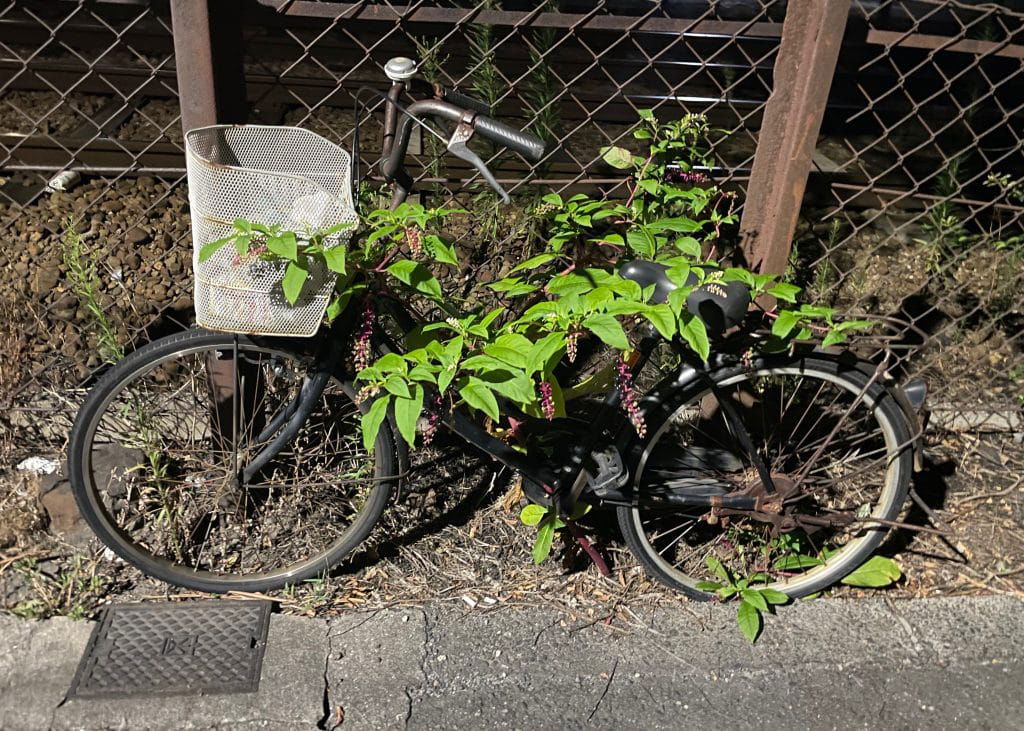
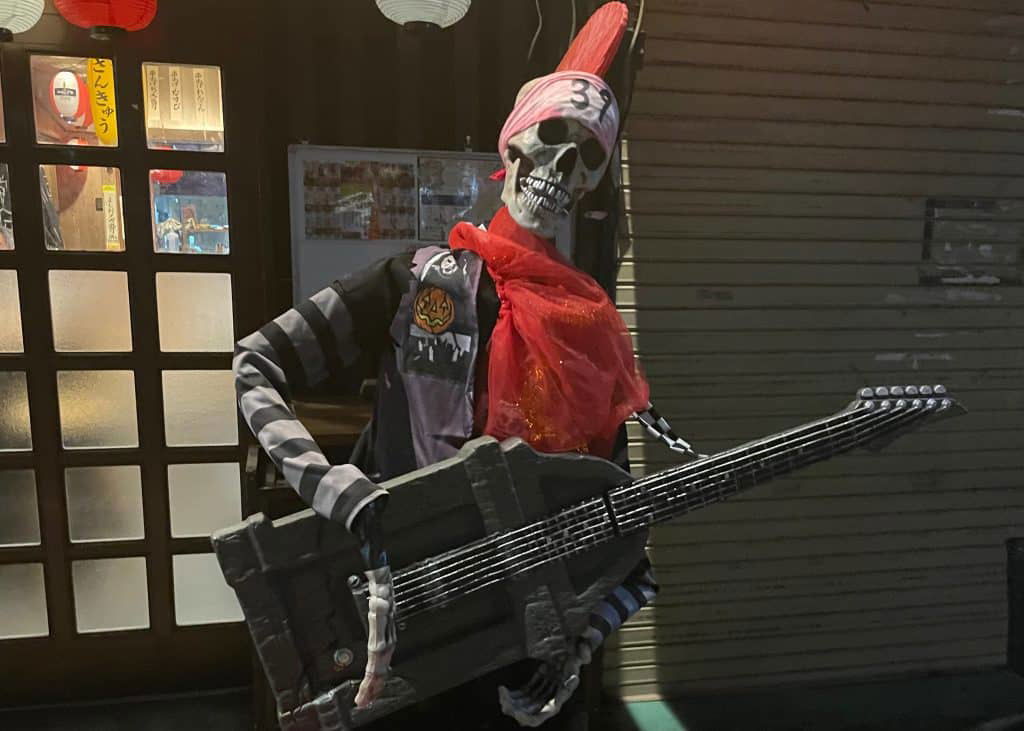
One the way I pass another old bicycle covered in vines, and I wonder how long it’s been there. It’s starting to resemble a piece of street art by this point. Our destination is about 8 minutes away, near Suminoe Station. George tells me that I can take the Nankai Line to get home if it gets to late. I come across a skeleton playing a guitar and think I might be seeing things. How much did I have to drink?
Rockability
Address:〒559-0005 Osaka, Suminoe Ward, Nishisuminoe, 2 Chome−1−23 プラザ志ビル 5 1階. Website. Instagram.
Our first stop is Rockability, the bar that features live music I had learned about at Bento no Moriya. The owner is a huge fan of The Stray Cats, but he says never got to see them live on their reunion tours of Japan. He says he saw The Brian Setzer Orchestra the last time they played Osaka. It’s fitting because his impressive hairstyle seems to be based on Brian Setzer’s famous quiff. There are some guitars displayed on the wall, but I don’t get a chance to ask him if he plays an instrument.
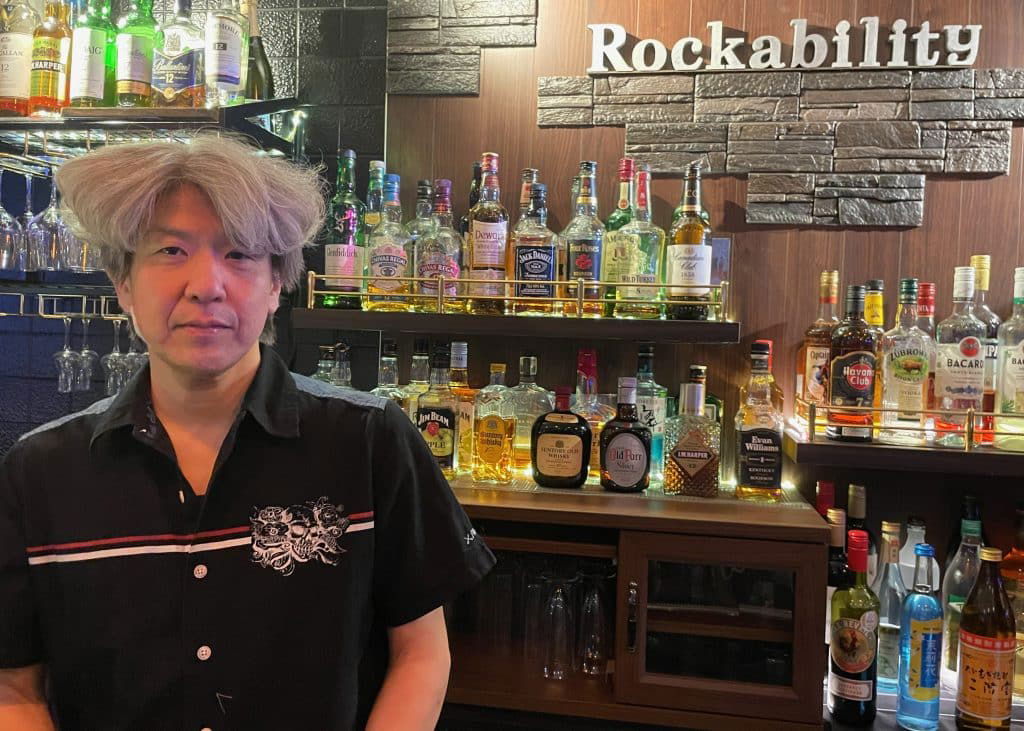
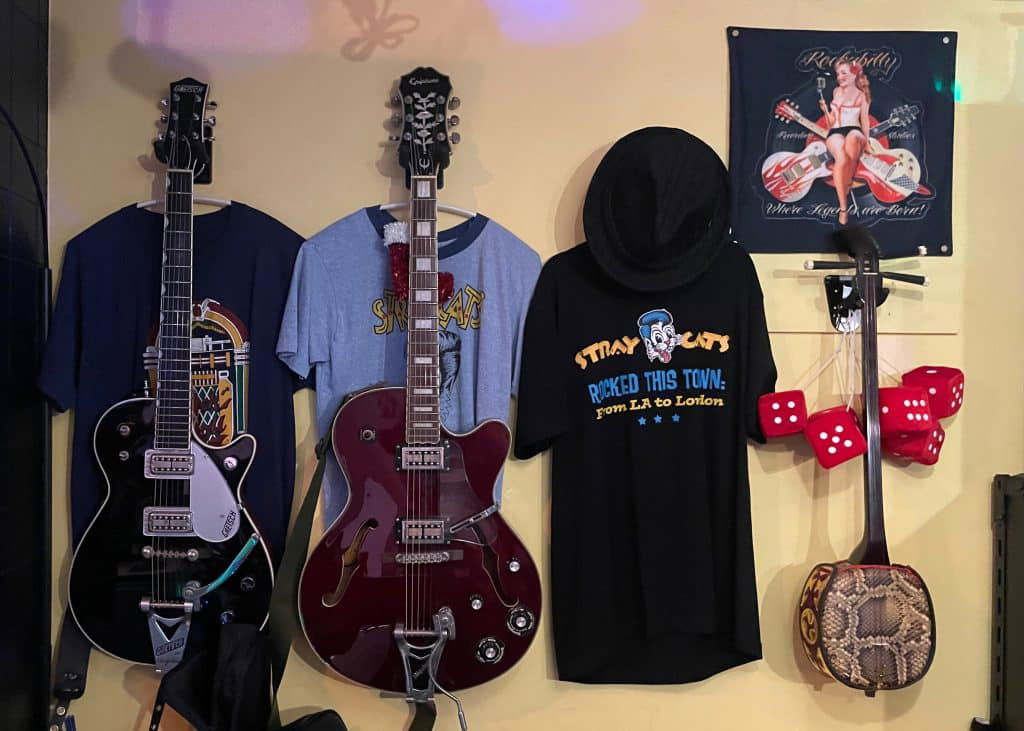
Cafe & Bar adagietto
Address: 2 Chome-1-25 Nishisuminoe, Suminoe Ward, Osaka, 559-0005. Instagram.
After ordering drinks at Rockability, I notice for the first time that George isn’t with us. Keith gives him a call and finds out he’s at Cafe & Bar Adagietto, just a few doors down. By this point in the night, things are starting to get a bit hazy, so I can’t tell you much about this cozy spot. However, the person who runs it greeted us warmly as soon as we walked in. George and Keith seemed to know everyone there, and it was uplifting to see how local businesses support each other in this area. Before we left, I asked the owner to take a photo of our group so I could remember this moment one of the best nights I’ve ever had in Osaka. I’m glad my wife forgot her hat.
